































Our high performance fasteners support safe and reliable transportation.


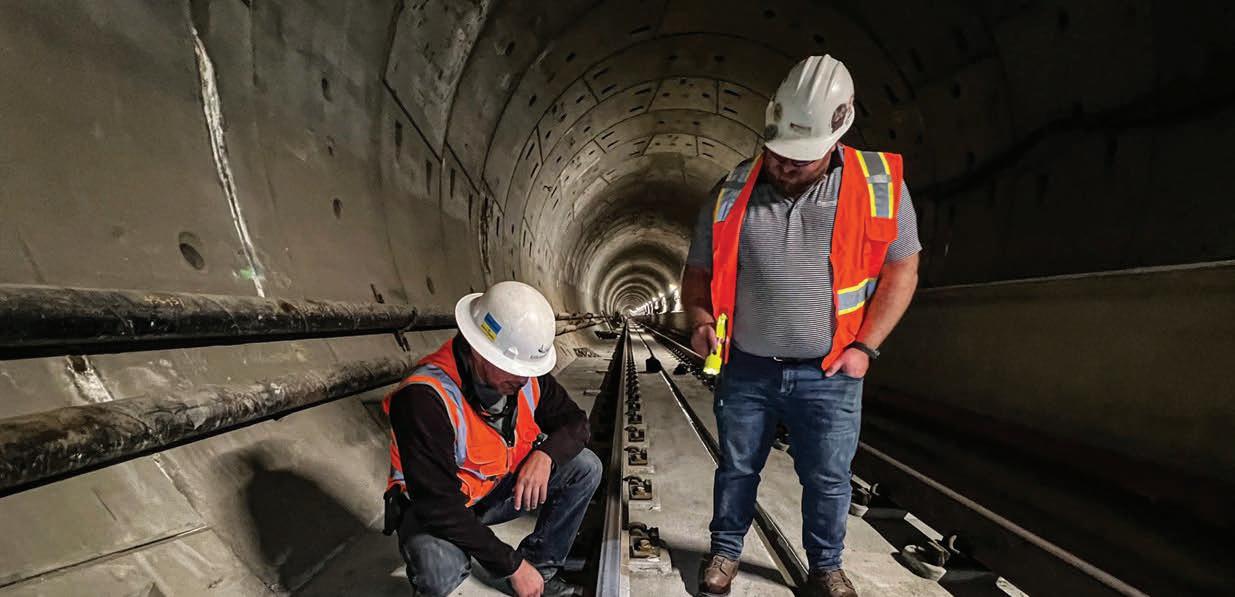
The GE11 e-style clip is produced with an innovative manufacturing process which signi cantly reduces internal stress, improving the fatigue performance beyond that of the legacy e-Clip.Approved and used by Class I and transit customers, these American-made fasteners are available in both right-handed and left-handed versions.Innovative fastener solutions are just one more way we keep you rolling.
We keep you rolling.


Full disclosure:
As far as I know, this column (indeed, everything in this issue, or for that matter on our website), has not been written by artificial intelligence, or with AI assistance. That applies to stories about AI as deployed for the greater good of the railway industry. We guarantee that the close-knit cadre of human beings at Simmons-Boardman Publishing (editors, publishers, advertising sales reps, etc.) will not be replaced with lines of computer code.
Others, however, have not been so fortunate. Consider the case of the Columbus Dispatch, one of monstrous publishing conglomerate Gannett’s numerous small properties.
The Washington Post (like Railway Age, written by humans) recently reported that readers of the Dispatch’s high school sports section “might have encountered a new sportswriter with a prolific byline—and an odd way with words.”
This “writer” called a high school football game a “close encounter of the athletic kind.” Another story described a scoreboard “in hibernation in the fourth quarter.” A description of a late comeback in another game said the winning team “avoided the brakes and shifted into victory gear.”
Who—or what—wrote these silly synthetic sentences? It was Lede AI, an AI company that “uses game scores to generate automated sports recaps for newsrooms,” The Post reported. “Lede AI’s stories in the Dispatch, which generally provided the outcomes of high school games and the scoring after every period of play, were blasted on social media as having a stilted tone and using
SUBSCRIPTIONS: 847-559-7372
EDITORIAL AND EXECUTIVE OFFICES
bizarre turns of phrase ... Lede AI-generated articles in the Dispatch and other Gannettowned papers were appended with a notice that they’d been updated ‘to correct errors in coding, programming or style.’ In a statement, Gannett called the deployment of Lede AI an ‘experiment’ in automation to aid its journalists and add content for readers: ‘We have paused the high school sports Lede AI experiment and will continue to evaluate vendors as we refine processes to ensure all the news and information we provide meets the highest journalistic standards.’”
“Automation is part of the future of local newsrooms,” Lede AI told The Post. AI “allows reporters and editors to focus on journalism that drives impact in the communities they serve.” The company’s website says its service is “a powerful tool for newsrooms that can produce hundreds of accurate and compelling news stories in seconds to help newspapers capture web traffic and subscribers.”
“Accurate and compelling”? Yeah, OK. Add “on the cheap” to that description!
Let’s see ... If local news stories on grade crossing collisions were generated by AI, you might read something like this:
“The close encounter between the train and the truck resulted in tiny injuries to the train’s driver because he threw out the air before letting go of the steering wheel and ducking. But the truck driver was unable to absorb the impact of the much bigger engine, which weighed a lot and didn’t feel like stopping fast.” Would you like me to turn this column over to a robot?
I’m sorry, Dave. I’m afraid I can’t do that.
Simmons-Boardman Publishing Corp. 1809 Capitol Avenue Omaha, NE 68102 (212) 620-7200 www.railwayage.com
ARTHUR J. McGINNIS, Jr. President and Chairman
JONATHAN CHALON Publisher jchalon@sbpub.com
WILLIAM C. VANTUONO Editor-in-Chief wvantuono@sbpub.com
MARYBETH LUCZAK Executive Editor mluczak@sbpub.com
CAROLINA WORRELL Senior Editor cworrell@sbpub.com
DAVID C. LESTER Engineering Editor/Railway Track & Structures Editor-in-Chief dlester@sbpub.com

JENNIFER McLAWHORN Managing Editor, RT&S jmclawhorn@sbpub.com
HEATHER ERVIN
Ports and Intermodal Editor/Marine Log Editor-in-Chief hervin@sbpub.com
Contributing Editors
David Peter Alan, Jim Blaze, Nick Blenkey, Sonia Bot, Bob Cantwell, Peter Diekmeyer, Alfred E. Fazio, Gary Fry, Michael Iden, Don Itzkoff, Bruce Kelly, Ron Lindsey, David Nahass, Jason Seidl, Ron Sucik, David Thomas, John Thompson, Frank N. Wilner, Tony Zenga
Art Director: Nicole D’antona
Graphic Designer: Hillary Coleman
Corporate Production Director: Mary Conyers
Production Director: Eduardo Castaner
Marketing Director: Erica Hayes
Conference Director: Michelle Zolkos
Circulation Director: Joann Binz
INTERNATIONAL OFFICES
46 Killigrew Street, Falmouth, Cornwall TR11 3PP, United Kingdom 011-44-1326-313945
International Editors Kevin Smith ks@railjournal.co.uk
David Burroughs dburroughs@railjournal.co.uk
David Briginshaw db@railjournal.co.uk
address to: Railway Age, PO Box 239, Lincolnshire, IL 60069-0239, USA.
Robert Preston rp@railjournal.co.uk
rights:
permission is granted by the copyright owner for the libraries and others registered with the Copyright Clearance Center (CCC) to photocopy articles herein for the flat fee of $2.00 per copy of each article. Payment should be sent directly to CCC. Copying for other than personal or internal reference use without the express permission of Simmons-Boardman Publishing Corp. is prohibited. Address requests for permission on bulk orders to the Circulation Director. Railway Age welcomes the submission of unsolicited manuscripts and photographs. However, the publishers will not be responsible for safekeeping or return of such material.
Member of:
Simon Artymiuk sa@railjournal.com
CUSTOMER SERVICE: RAILWAYAGE@OMEDA.COM , OR CALL 847-559-7372
Reprints: PARS International Corp. 253 West 35th Street 7th Floor New York, NY 10001 212-221-9595; fax 212-221-9195 curt.ciesinski@parsintl.com




“It doesn’t bode well for total carloads when coal, chemicals and grain—typically the three highest-volume carload categories for U.S. railroads—all decline, but that’s what happened in August,” the AAR reported last month. “U.S. carloads of grain in August were down 22.9%. July and August 2023 were the two lowest-volume grain months for U.S. railroads since sometime prior to 1988, when our data begin. Blame weak grain exports. Chemicals fell 0.6% in August, their 11th decline in 12 months; year-to-date carloads were 1.09 million, down 3.3% but still the second most ever for the first eight months of a year. Year-to-date coal carloads were 2.30 million, virtually unchanged. Total U.S. electricity generation was down 4.0% in the first half of 2023, but generation from coal was down 27.3%. Excluding coal, U.S. carloads fell 1.7% in August and were up 0.1% year to date. On the plus side, carloads of motor vehicles and parts led the way for U.S. railroads in August: Carloads were up 13.6%, their 17th straight year-over-year increase. U.S. intermodal originations were down 6.3% in August 2023 from 2022, their 24th year-over-year decline in the past 25 months. However, originations averaged 247,858 units per week in 2023, the most in 10 months. Intermodal remains subpar for a number of reasons, including a continuing shift in consumer spending away from goods to services, a related sharp downturn in port activity, and tougher price competition from trucks.”
(% change from AUGUST 2022)
Transportation (train and engine)
52,102 (+6.85%)
Executives, Officials and Staff Assistants
8,232 (+4.20%)
Professional and Administrative
10,327 (+5.47%)

Maintenance-of-Way and Structures
28,994 (+1.96%)
Maintenance of Equipment and Stores
18,258 (+4.87%)
Transportation (other than train & engine)
4,879 (+3.46%)
Source: Surface Transportation Board
TOTAL North American CARLOADS, AUG. 2023 VS. AUG. 2022
1,657,9071,666,976



TOTAL U.S. Carloads and intermodal units, 2014-2023 (in millions, year-to-date through AUGUST 2023, SIX-WEEK MOVING AVERAGE)
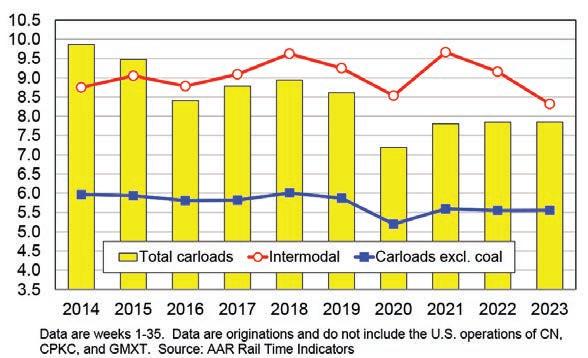
BY UNANIMOUS VOTE, THE SURFACE TRANSPORTATION BOARD (STB) ON SEPT. 7 ISSUED A NOTICE OF PROPOSED RULEMAKING (NPRM) THAT IT SAID FOCUSED ON “PROVIDING RAIL CUSTOMERS WITH ACCESS TO RECIPROCAL SWITCHING AS A REMEDY FOR POOR SERVICE.” IT CALLED THE MOVE “AN IMPORTANT STEP IN ADDRESSING THE MANY FREIGHT RAIL SERVICE CONCERNS EXPRESSED BY STAKEHOLDERS SINCE 2016.” Comments were due by Oct. 23 (the AAR filed for a 90-day extension). STB said it anticipates “acting expeditiously” on the proposal.
“In the past several years, it has become clear that many rail customers nationwide have suffered from inadequate and deteriorating rail service,” STB Chairman Martin J. Oberman (above) said. “These problems were documented in detail in hearings conducted by the Board in April 2022 … The Board has continued to closely monitor the state of rail service.

“For this reason, the Board has determined to focus its efforts with respect to reciprocal switching on providing relief to rail customers suffering from poor service. With the issuance of today’s NPRM, the Board is proposing that one approach to improving rail service is to afford affected shippers the opportunity to obtain a reciprocal switch to a competing Class I carrier when service falls below a standard set in the proposed rule.
“The new rule contains a distinct advantage over both the existing regulations and the
proposal in the 2016 NPRM [Docket No. EP 711 (Sub-No. 1)]. The proposed new rule sets specific, objective and measurable criteria for when prescription of a reciprocal switching agreement will be warranted. This rule will bring predictability to shippers and will provide Class I carriers with notice of what is expected of them if they want to hold on to their customers who might otherwise be eligible to obtain a switching order. As a result, litigation costs to obtain a switch should be greatly reduced and petitions to obtain a switching order should be able to be litigated much more swiftly.”
The NPRM’s release closed Docket No. EP 711 (Sub-No. 1) and proposes, in a new Subdocket (Docket No. EP 711 [Sub-No. 2]), a new set of regulations that would provide “a streamlined path for the prescription of a reciprocal switching agreement when service to a terminal-area shipper fails to meet any of three performance standards.” The proposed standards, STB explained, “are intended to reflect a minimal level of rail service below which a shipper would be entitled to relief, and each standard would provide an independent path for a petitioner to obtain prescription of a reciprocal switching agreement.” STB said they are “intended to be unambiguous, uniform standards that employ Board-defined terms and are consistently applied across Class I rail carriers and their affiliated companies.” The three STB-proposed standards are:
1. Service Reliability. This is defined as the “measure of a Class I rail carrier’s success in delivering a shipment by the original estimated time of arrival (OETA) that the rail carrier
provided to the shipper.” The OETA “would be compared to when the car was delivered to the designated destination and would be based on all shipments over a given lane over 12 consecutive weeks.” One proposed approach “would be to set the success rate during the first year after the rule’s effective date at 60%, meaning that at least 60% of shipments arrive within 24 hours of the OETA, and increasing the success rate thereafter to 70%.” STB also seeks comment on other approaches, such as “maintaining the required success rate at 60% permanently or raising it to higher than 70% after the second year.” Phasing in a higher success rate over time would provide the Class I railroads “with time to increase their work forces and other resources, or to modify their operations, as necessary, in order to meet the required performance standard.”
2. Service Consistency. This is the “measure of a rail carrier’s success in maintaining, over time, the carrier’s efficiency in moving a shipment through the rail system.” The service consistency standard “is based on the transit time for a shipment, i.e., the time between a shipper’s tender of the bill of lading and the rail carrier’s actual or constructive placement of the shipment at the agreed-upon destination.” The NPRM proposes that, “for loaded cars, unit trains and empties, a petitioner would be eligible for relief if the average transit time for a shipment increased by a certain percentage— potentially 20% or 25%—as compared to the average transit time for the same 12-week period during the previous year.”
3. Inadequate Local Service. This is defined as the “measure of a rail carrier’s success in performing local deliveries (‘spots’) and pickups (‘pulls’) of loaded railcars and unloaded private or shipper-leased railcars within the applicable service window, often referred to as ‘industry spot and pull’ (ISP).” The NPRM proposes that a railroad would “fail the standard” if it had an ISP success rate of less than 80%, over a period of 12 consecutive weeks, in performing local deliveries and pick-ups within the applicable service window. “The ISP success rate would measure whether the carrier provides the service within its customary operating window for the affected shipper, which in no case can exceed 12 hours. This service metric provides rail customers with the longsought-after information on all important first mile/last mile service.”
L.B. FOSTER last month extended its partnership with lubricant manufacturer FUCHS LUBRICANTS CO. to rail markets in South America, Australia and China. The partnership, L.B. Foster says, combines its “expertise in the deployment of Total Friction Management® (TFM) solutions for the global rail industry with FUCHS’s manufacturing capabilities and world-class lubrication solutions for railway traffic. We offer rail customers trackside and on-board friction management solutions, and pioneered TFM for the rail freight, passenger and urban transit sectors. TFM is how we work with railroads around the world to deliver holistic, optimized friction management programs.” FUCHS is a global company that develops, produces, and distributes more than 10,000 lubricants and related services.
Siemens Mobility will supply six additional SC-42DM dual-mode (diesel-electric/third-rail) Charger locomotives to MTA MetroNorth Railroad, building on an initial 27-unit order placed in 2020. The Connecticut Department of Transportation (ConnDOT) is funding these six. M-N’s base order was for 19 units, expanded to 27 (all funded by the New York MTA) with exercise of a first option. This second option brings the total to 33. Options remain to purchase 32 additional units, along with 14 more for ConnDOT, 25 for the New York State Department of Transportation (NYSDOT) and 60 for MTA Long Island Rail Road (LIRR). The new power will replace GE P32AC-DMs, which have either reached or exceeded their projected 25-year lifespan. The original contract encompasses, with all options, up to 171 SC-42DMs for Metro-North, LIRR and NYSDOT, the latter for Amtrak Empire Corridor service. They will be built in Siemens’s Sacramento, Calif., facility to the current EPA Tier IV standards for operation in the Park Avenue Tunnel and on thirdrail territory across New York State.

THE GREENBRIER COMPANIES last month boosted its order book by 15,300 railcars in its fiscal fourth quarter ending Aug. 31, 2023. Customers operating in “various commercial sectors” are purchasing a “range of railcar types” with an aggregate value of $1.9 billion, the manufacturer reported. Greenbrier did not disclose the types of railcars or the customers. According to Greenbrier, “broad demand” across all railcar types led to its highest quarterly orders in nearly a decade, and the orders demonstrate its “lease origination capabilities balanced with its direct sale expertise.” Certain orders, the company added, are subject to “customary documentation and completion of terms.”
AMERGIN ASSET MANAGEMENT
(AAM) last month announced that its portfolio company AMERGIN RAIL has acquired PNC BANK’S operating railcar portfolio, including the purchase of more than 6,000 railcars under management, which are under lease to a variety of companies across the U.S. PNC will continue to provide traditional financing products and services to the rail and transportation industry. MACQUARIE CAPITAL acted
as exclusive financial advisor to AAM; EVERSHEDS SUTHERLAND (US) LLP acted as external M&A and rail leasing legal counsel to AAM and Amergin Rail; and WOMBLE BOND DICKENSON (US) LLP acted as external rail leasing legal counsel to Amergin Rail in connection with the acquisition.
STV has contracted with Arizona’s VALLEY METRO REGIONAL PUBLIC TRANSPORTATION AUTHORITY (VALLEY METRO), in partnership with the cities of Tempe and Mesa, to serve as lead planner and designer to expand the three-mile, 14-stop Tempe Streetcar system, which launched May 20, 2022. The Rio East-Dobson Extension project will evaluate adding approximately four miles of track from downtown Tempe into Mesa, Arizona’s third-largest city. STV is the lead designer for the project and PARTNERS IN ARCHITECTURE is the architect of record. STV will conduct an alternative analysis to consider and evaluate the line’s configuration and how it can best connect various regional activity centers, employment centers and residential areas.
Who, pray tell, is the vampire? Is it railroads, allegedly abusing their market power to drain from captive shippers monopoly pro ts? Or is it aggrieved shippers, urging the Surface Transportation Board (STB) to poach from railroads the fruits of enterprise essential to maintaining and renewing plant and equipment?
Don’t look to the law for answers. In partially deregulating railroads in 1980 (Staggers Rail Act), Congress created con icting objectives. Regulators were instructed to protect captive shippers from railroad market power abuse while simultaneously assisting railroads in earning their cost of capital (revenue adequacy).
Nor is the answer available from the STB, o scolded for delay and favoritism.
ere was no burnishing of the STB’s image last month when the ve-member Board unanimously voted—Reciprocal Switching for Inadequate Service, Docket No. EP 711 (Sub-No. 2)—to shi focus from increasing shippers’ competitive options to measuring service standards as a pre-condition for competitive enhancements.
If the STB’s assumption is that railroads are in business to sell shoddy service at in ated prices, it possesses authority to create e cient and e ective remedies— competition—without painting a new face on a rulemaking dating to 2011 and with roots to 1985.
e STB’s unused and rusting tools include capping rates for revenue adequate railroads; requiring reciprocal switching at sole-served shipper origins and destinations (the interchange of freight cars with a competitor at the nearest feasible junction); or requiring the sole-serving railroad to quote a rate to such a junction over the bottleneck (railroads now are required only to quote a rate from origin to destination no matter that they have an origin and/or destination monopoly).
Regulators ruled in 1985 (Coal Rate Guidelines) that once a railroad achieves revenue adequacy it be subject to a rate cap and “not consistently earn, over time, a return on investment above the cost of
capital.” Yet regulators dither over enforcement, notably ignoring tens of billions of dollars in stock buybacks by railroads, billions of dollars in asset value premiums paid to acquire competitors or o ered for them by hedge funds, and that no railroad has told investors it is revenue inadequate.
At sole-served shipper facilities, competition can be enhanced by requiring unbundling of service or rates. Long available in Canada with no railroad objection—in fact, o ered by Canadian Paci c and Kansas City Southern in their merger application and advocated by then-CP CEO Hunter Harrison when he sought to acquire Norfolk Southern—is a reciprocal switching remedy. It allows a captive shipper to demand its cars be interchanged at the soleserved origin or destination with a second railroad at a feasible junction, allowing for negotiation of a lower rate on the longer, more pro table (to the railroad) linehaul, and pressures the sole-serving railroad to improve service and o er a lower origindestination rate.
A second remedy at bottleneck origins and destinations is for the sole-serving railroad to quote a separate rate for the bottleneck segment (subject to challenge before the STB). Rate unbundling similarly allows shippers to negotiate a lower linehaul rate with a second carrier. Such competition mirrors what the Federal Communications Commission and Federal Energy Regulatory Commission mandate of telecommunications, wholesale electric power and natural gas carriers.
While shippers publicly praised the STB’s Sept. 7 ruling (who but Donald Trump speaks resentfully of magistrates holding one’s fate?), their con dential assessment is condemnatory, such as: “Despite shippers having for decades put together an exhaustive record on railroad market power abuse, the STB has proposed new rules based on service failures and no rules based on competition failures— not even a schedule or commitment with respect to competition rules.”
Why the STB terminated its focus on competitive remedies that railroads adamantly oppose is open to conjecture,
as the STB provided no explanation for its action. Undeniable is that the pivot betrayed the primary complaints of captive shippers—a lack of rate competition and prohibitive hurdles to bringing and pursuing rate complaints before the Board.
What the STB has done is once again kicked the can down the road.
(Frank N. Wilner’s new book, Railroads & Economic Regulation, is available from Simmons-Boardman Books at www.transalert.com, 800-228-9670.)
FRANK N. WILNER Contributing Editor

Why the STB terminated its focus on competitive remedies that railroads adamantly oppose is open TO conjecture, as the STB provided no explanation for its action.”


 By David Nahass, Financial Editor
By David Nahass, Financial Editor





 BY DAVID NAHASS, FINANCIAL EDITOR
BY DAVID NAHASS, FINANCIAL EDITOR
elcome to Railway Age ’s 2024 Railroad Financial Desk Book. Fall is upon North American rail. It is a time for the grain harvest and a time to begin reflection on what the year has delivered and an opportunity to look forward to the future. It is a time for closing the Southern border as South and Central American migrants decide that the roof of a covered hopper car is the new passenger ship to freedom and the American Dream and that Eagle Pass, Tex., is the new Ellis Island. After a four-day border closing by U.S. Customs and Border Protection, Union Pacific reported a 24-train backup in both directions equivalent to 32 miles.
Sociologists suggest that nostalgia tends to mute the more challenging



Waspects of our collective past in favor of a rosier, recollective narrative. (The memory of Hunter Harrison may disagree with the rosier look at one’s past.) In a recent article in the Los Angeles Times , a study from the American Enterprise Group was cited indicating that the 1980s and 1990s are replacing the 1950s as the era on which people reflect as “the good old days.”
Imagine that! The Eighties! Respectability! For industry veterans, let’s all go back to the pre-Staggers era. The article goes on to say that in the 1930s, people thought the good old days were the horse and buggy era. Human nature is a fallible thing.
When were the good old days of intermodal loadings? Was it the robust loadings of 2018? In 2023, intermodal loadings continue to languish down 8.7%


for the year (through Sept. 16, 2023, and after a better-than-expected August). At the most recent Intermodal Association of North America (IANA) Expo Conference in Long Beach, Calif., Journal of Commerce correspondent Ari Ashe noted in reporting about the state of the intermodal market, “While intermodal train speeds were up 3.8% and on-time performance was 12% higher year-over-year in the first week of September, shippers remember the subpar service that existed between 2020 and 2022.”
Intermodal loadings are the hangover that won’t go away. Remember when intermodal was going to be the great growth engine of rail for the 21st century? That’s so 2000s and 2010s and 2020s and … Except for the fracking boom, which gave intermodal a rail pass level moment of silence, intermodal (or Bruce Kelly



























as Tony Hatch would call it, “The Great Experiment”) has been the unfulfilled promise that couldn’t or hasn’t.
Ashe continues in his article: “North American railroads are moving to reverse a multi-year loss in market share … by fixing … root causes … including unreliable service [and] uncompetitive pricing.” Focus on the latter point for the moment and realize that one reason that the railroads have been so blasé about intermodal service is that the operating ratio is generally higher on intermodal business than on other types of freight.
Heading into 2023’s fourth quarter, early year projections on a rebound are falling flat. The grip of a potential recession (and contrarily, the chances for sticking a soft landing) seems a little stronger. That does not bode well for recovery.
Some factors such as a change in how railroads handle the first and last mile for intermodal shipments that may improve the throughput of intermodal trains are fundamental supply chain changes that may be a generation in the making. As an industry, change is not something we do well, and there is no nostalgia for a time

when rail pivoted with great rapidity. Issues related to length of haul play a factor in intermodal’s future. After the West Coast pandemic-related container ship pileup, loads moved to the Southeast and the Northeast. The Panama Canal is having to place restrictions and penalty payments on certain types of shipments due to operating issues resulting from water supply. This could direct more traffic back to the West Coast (especially after the settling of labor-related issues at the Port of Long Beach). The Wall Street Journal has a video explaining the reason for Panama’s operational issues that is worth a viewing.
In previous musings, “Financial Edge” has highlighted how intermodal loadings have always bounced back from downturns with relative ease. Perhaps that is what the industry has to look forward to in 2024. Maybe it won’t be eye-popping, but as the cheap romance novelists like to say, “life isn’t always pretty but it is always beautiful.”
It was a really great time to be writing a lengthy article about railcars and finance. The Federal Reserve’s Sept. 20 decision to hold interest rates level while
projecting another increase between now and the end of 2023 was not unexpected. Pretty? Probably not. The Fed’s unanswerable question seems to be what the magic interest rate will be that will slow down unemployment and hold inflation at the targeted 2%. For years, that number (for the ten-year Treasury bond) seemed to be somewhere between 2% and 3%.
Interest rates are an impact factor in rail finance. Using some loose estimates, a 1% increase in interest rates can equate to an increase in lease rates on a railcar of $100 per car per month. (Sit down if you need to.) If you happened to be considering leasing a railcar in October 2021 (when the ten-year Treasury was about 1.5%), the cost adjustment (based on interest rates alone) could be equal to $300 per car per month for each month of your lease term. (The ten-year Treasury is just about at 4.5% after the Fed’s recent pronouncements.)
It’s just enough to have one wishing for the good old days of the 1980s and 1990s! Before going all in on purchasing a pair of vintage “Risky Business” Wayfarers (“Risky Business” was a popular movie in Bruce Kelly
















































With nearly 140 years of financial strength and stability, DJJ is also known for our creative transportation solutions. Contact us today to discuss private fleet or leasing options. RailGroup@djj.com www.djj.com














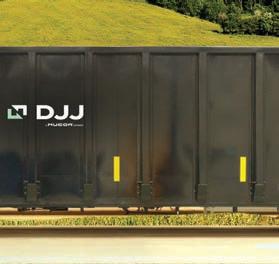









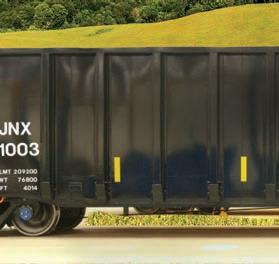



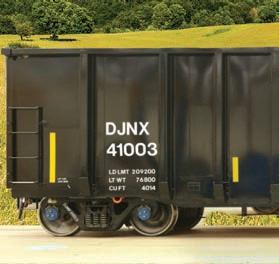
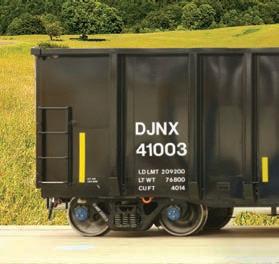




1984 that launched Tom Cruise’s lengthy movie career— yes, Tom Cruise is that old), check the facts. For those of you who were able to keep score at home in the early ’80s, the ten-year Treasury was 15% in 1981 and didn’t stabilize at today’s levels until the turn of the century. The only good things to buy in the early 1980s were municipal and Treasury bonds.
In addition, The Greenbrier Companies (whose fiscal year end is Aug. 31), announced earnings on Sept. 21 and announced what felt like the railcar industry equivalent of a quarterback dropping a dime in the fourth quarter of a close game. The revelation that Greenbrier had secured orders for 15,000 railcars in its fiscal fourth-quarter 2023 was material indeed. This is more surprising, considering that orders in the second quarter of calendar-year 2023 were 16,194 for all builders. The total value of Greenbrier orders: a cool $1.9 billion. But keep the facts straight: With Greenbrier’s fiscal year reporting including the calendar month of June 2023, there is some overlap between the eye-popping RSI American

Railway Car Institute Committee secondquarter 2023 order number and the equally eye-popping Greenbrier fiscal fourth-quarter order number.
Greenbrier did not provide much granular detail for the orders received. Clearly, some cars are for European orders (Greenbrier has European manufacturing facilities in Poland, Romania and Turkey) and they indicated that there were no multi-year orders. (This refers to a GATX-style multi-year.)
Certainly, no one expects Greenbrier to build only these 15,000 cars and not add to their prodigious backlog. In addition, at the recent 16th annual TD Cowen Global Transportation Conference, Greenbrier in its presentation (available on its website) noted that it expected new car production for the next three years to be around 40,000 cars annually. As of June 30, 2023, Greenbrier had 41% of the North American railcar manufacturing backlog of roughly 60,000 railcars. If these orders were all U.S. based, that would raise Greenbrier’s North American backlog to almost 40,000
railcars. Put all that together, and the 15,000 additional cars would suggest that Greenbrier’s deliveries are out until 2025. Knowing that at least a portion of the orders received by Greenbrier were European clearly matters, but concerns about scale are still warranted.
An industry contact marveled at this most precise example of the inelasticity of supply in the railcar market right now. It will be interesting to see where Trinity, FreightCar America and National Steel Car orders come in from the third quarter. Furthermore, it will be even more interesting to see how high the backlog and how long the delivery window will need to get until the OEMs decide to start building more than 40,000 cars annually.
Any continued strengthening of loadings will continue to require more equipment. Roughly 20% of the national eet of railcars is in storage. Most of those have been there for some time and many will never move again. With general freight loadings neutral for 2023 (thanks to all you automobile purchasers), any additional demand will continue to stress car supply.
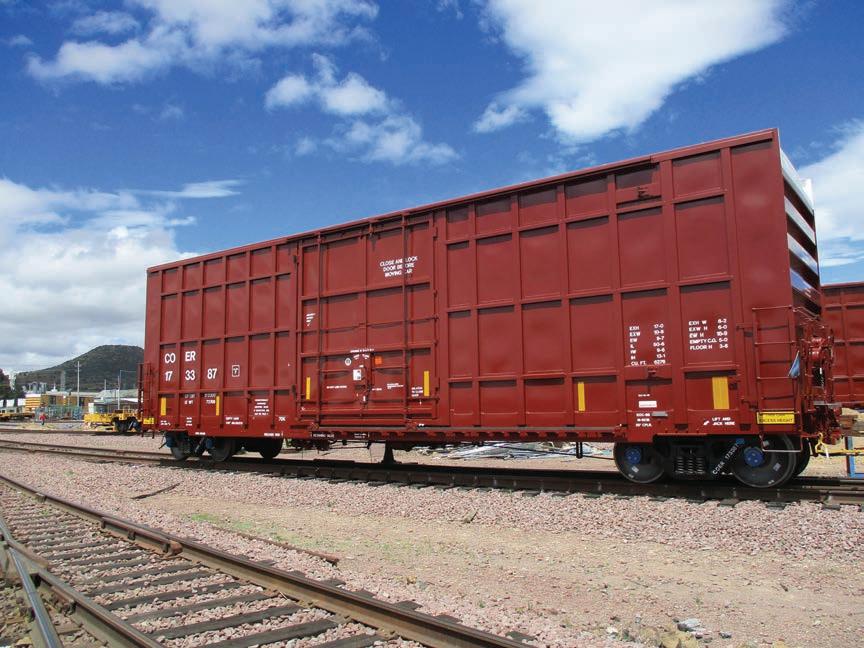
It’s difficult to find balance between adequate supply and over supply. As an industry, railcar manufacturing has historically struggled to do this. The inelastic supply mentioned above is a new twist for railcars and railcar manufacturing. It will be interesting to see if it sticks, or maybe even more so to find out what throws it off kilter. A return to the good old days of railcar manufacturing and its boom/bust cycles shouldn’t really be on anyone’s agenda. Good luck closing out the year successfully.
Railcar users of all types are spending time in hindsight thinking about the rates they could have locked in for the long term when it felt like the siren song of low-cost lease rates and flexible terms would never come to an end. TD Cowen’s Matt Elkott has suggested that lease rates may have peaked in the most recent quarter. The question is, will today’s currents rates, even if
they plateau, remain at lofty levels?
Current car supply levels (Greenbrier orders notwithstanding), service levels and interest rates suggest that there is some grip to today’s economics. Lessors generally are pushing lease terms. Rates quoted here are five to seven years generally. Expect shorter-term leases to be more costly across all car types.
Here’s what’s going on in the market:
Coal Cars: Coal loadings have been flat for the year, but coal generation is down to 14% of overall energy generation in the U.S. Even with advances in carbon sequestration, the flame here continues to flicker. But with car supplies lower, demand continues, and rates remain elevated. For rapid discharge cars (if one can find them) expect lease rates in the high $300s full service (FS), with some uplift for terms of less than three years. For gondola railcars expect rates in high $200s to low $300s. Rates here continue to stay at elevated levels despite dropoffs in the cost of natural gas drifting well
below the $3.50 to $4.00 MMBTU price generally viewed as the cost threshold for moving and burning coal vs. burning natural gas. While car owners may be wishing for the good days of the 1990s, this is a better alternative than what was available in the 2019 timeframe. Expect rates to continue to hold at these levels.
Mill Gondolas: The high price of new cars really has an impact here. While scrap is holding at reasonable levels, loadings are up year-over-year (YOY) with service stressing car supply. Age matters more here than with other car types. Looking for 52-foot (Eastern scrap) gons? Expect lease rates in the mid-$500s. Need a car that works out West? Sixty-six-foot mill gondolas are in the mid- to high$600s. Do expect a slight autumnal drop in scrap prices (currently at $325 a ton for Chicago heavy melt #1) to be a high impact near-term factor.
Centerbeam Flat Cars: Oh wither the housing market! Wall Street seems bullish on builders even with mortgage
WorkSiteTrainingCourses:
Locomotive:
• TestingandTroubleshooting26-Type LocomotiveAirBrakeSystems
• LocomotivePeriodicInspectionand FRARulesCompliance
• LocomotiveElectricalMaintenanceand Troubleshooting
• LocomotiveAirBrakeMaintenanceand Troubleshooting
• DistributedPowerMaintenanceand Troubleshooting
• DistributedPowerOperations,Training,and OperatingRules
FreightCar:
• FreightCarInspectionandRepair
• SingleCarAirBrakeTest

• FRAPart232BrakeSystemSafetyStandards forfreightandothernon-passengertrains

• TrainYardSafety

Track:
• TrackSafetyStandards
rates up to a high 7%. (Miss the good old days? In 1982, the 30-year mortgage rate peaked at 18% and was nary below 7% until after 2000). The Association of American Railroads notes that a lack of sales of existing homes supports new builds. That suggest some strength in the loads here. Look for continued strength in this car class and rents in the low-$400s.
Tank Railcars: A bevy of cars moving in energy service continue to remain in demand: DOT 117Js are running north of $1,000 per car per month. DOT 117Rs are in the high $800’s/low $900s. Both of those are 29,000-gallon tank railcars; 25,500-gallon tank railcars cars are a little softer and more readily available. Want pressure cars? Expect the pressure here as rates are in the $1,000 range FS. The slide in natural gas has impacted this market, but a cold winter could shift these prices higher. Food grade tanks are not much better, with rates in the high$900s or low-$1,000s.
Covered Grain Hoppers: Ah, remember the good old days when lessees could lease jumbo cars for less than $400? Oh wait, that was early 2020. Back to the now, nothing says service matters like a market segment where loadings are down 13% YOY and rates continue to remain firm and at the highest levels in the past 20 years. Jumbo hoppers continue to command lease rates in the low $600s. If you’re able to use a smaller car, expect to pay in the low-$400s for the 4,750cf car, with possible sightings of numbers in the high-$300s.
Covered Cement and Sand Hoppers: A prodigious number of covered hoppers remain in storage. One would assume that a number of these are smaller cube. Despite what continues to seem like an oversupply issue, rate grip is a real thing here, with rates in the midto high-$200s. Attribute it to the costs of moving cars into service (repair shop and empty freight). As a result, cars are also transacting at higher sale prices.
Kawasaki Rail Car - Track Technologies
Kawasaki’s Maintenance Platform provides a customized suite of software that synthesizes data from multiple track maintenance sources.
Expect the older fleet to slowly continue transitioning to newer cars and for these lease rates to stay in place for some time to come.
Boxcars: A little softness here as the paper market has been seeing some price compression and weakness. There might be a little near-term softness as new cars being built (primarily for TTX) get absorbed into the fleet. The long-term perspective here is strong with the aging out of such a large percentage of the national fleet over the next eight years. It’s a commodity business, folks, so there will be ebbs and flows. Fifty-foot boxes have moved back into the mid-$500s, while 60-foot boxes are sitting in the mid-$600s. Those are low prices when compared to the cost of a new boxcar, so don’t expect those rates to remain. I have resisted the urge to talk about the good old days and grandfathered boxcars.


For all your rail leasing and financial needs Infinity
Infinity Transportation provides leasing and financing solutions for a broad range of clients in the rail and intermodal markets.

INFINITY DELIVERS:
• A large rail fleet with an extensive range of car types

• Exceptional customer service with flexibile lease terms
• A commitment to finding the transaction and equipment that meets each customer’s specific needs




• Extensive transportation experience within our Mechanical, Operations and Commercial Teams.
Kawasaki’s Track Monitoring provides locomotive mounted autonomous track inspection systems for geometry and components.


www.kawasaki-track.com
(251) 654-2166
infinitytransport.com



Bundy Group is a boutique investment bank that specializes in representing business owners and management teams in business sales, capital raises and acquisitions. e rm is a senior-driven organization with o ces in Charlotte, New York and Virginia. Bundy Group has been a recognized expert in the rail and transportation industry for more than a decade and has numerous successfully closed transactions in the segment. In representing a business and its shareholders in exploring a sale or recapitalization, Bundy Group is focused on managing a structured process and delivering premium value for its clients. For more information about Bundy Group’s work in the rail space, please contact Jim Mullens at jim@bundygroup. com or at 540-342-2151. For more information about Bundy Group visit www.bundygroup.com.
DJJ A NUCOR COMPANY
300 Pike Street, Cincinnati, Ohio 45202; Tel.: 513-419-6200; Fax: 513-419-6221; Trey W. Savage, Director Logistics; Luke Weatherhead, Manager, Private Fleet; Je Schmutte, Je Blake, and Eric Hausfeld, Regional Rail Sales; Steven R. Skeels, Mechanical Services Lead; and Ann Edwards, Retired Rail Assets (502-212-7365). DJJ’s Rail Group provides a broad range of transportation services throughout North America: single investor, leverage leases, freight cars, portfolio evaluation, remarketing eet management, purchases and sales of portfolios, and private eet management. Other services include freight car inspections and engineering services from design of new cars to complete ISL extended life, modi cations and analysis; in addition to railcar dismantling for scrapping and parts reclamation.
SEE OUR AD ON PAGE 13
RAILROAD FINANCIAL CORPORATION
676 N. Michigan Avenue, Suite 2800, Chicago, IL 60611; Tel.: 312-222-1383; Fax: 312-222-1470; David G. Nahass, President, Email: dnahass@ rail n.com; William J. Geiger, Senior Vice President, Email: wgeiger@rail n.com. RFC represents domestic and international clients in the following areas: debt and lease nancing of all railcar types including coal cars, tank cars and covered hopper cars for sand and plastics; railcar and locomotive eet acquisitions and sales; lease brokerage; mergers and acquisitions; equity and debt nancing of rail property acquisitions, eet and lease restructurings and/or re nancing. RFC also
provides continuing education for the industry.
RR MERGERS & ACQUISITIONS
11 e Pines Court, Suite B, St. Louis, Missouri 63141; Tel: 314 878-1414; Fax: 314-878-1414; Robert Fowler, President, 314 878-1414 x227 Email: robert@rrmergers.com. Jack Sickles, Vice President, 314 878-1414x221 Email: jack@rrmergers. com. RR Mergers & Acquisitions has specialized in the sale of rail-focused companies for more than 15 years. Trusted professionals with long-standing relationships in the rail sector, RR Mergers interfaces with strategic and nancial buyers nding the right buyer for a Company, to make the best deal happen. While maintaining con dentiality at all times, RR Mergers manages the total process of selling railroad industry suppliers, rail services companies and Short Line Railroads. RR Mergers provides advisory services to prepare the company for acquisition, developing a con dential information memorandum, negotiating term sheets, letters of intent and coordinating the due diligence process.
1700 Sansom St., Suite 500, Philadelphia, PA 19103; (215) 564-3122. Michael Sussman, President and CEO. SRF has served for 23 years as trusted advisor to Class I and short line railroads, rail shippers, public sector agencies, and industrial developers. e rm has brought capital, clarity, and velocity to infrastructure development projects in 45 states and Canadian provinces. SRF integrates capital from public programs and private sources with growth marketing strategies and management consulting to position executives toward shortterm objectives and long-term opportunities.
3201 Dallas Parkway, Suite 800, Frisco, TX 75034. Tom Forbes, Executive Vice President and Chief Sales O cer. (469) 777-5649 (o ce); (615) 290-3069 (mobile). Wintrust Commercial Finance (WCF) is Wintrust’s Texas-based, equipmentfocused nancing group o ering sophisticated loan and lease products to companies throughout the United States. Our team o ers exceptional customer service and expertise from years of experience providing customers in a variety of industries with innovative capital solutions. WCF funded in excess of $3 billion in equipmentsecured loans and leases since our founding in 2015 and has continued to grow into one of the largest equipment nancing companies in the country. WCF is led by an experienced management team with, on average, 25 years of experience. With
the team’s extensive knowledge, we’re prepared to consider all structures, including structured nancing and loans; nancing for new and used equipment acquisitions; re- nancings and estate planning; capital, operating, synthetic, and TRAC leases; sale/leaseback and lease discounting; capital expenditure nancing with xed and oating rates and acquisitions. For more information, visit http://www.wintrust.com/business-solutions/ mid-market/lending/commercial- nance.html.
AMERICAN INDUSTRIAL TRANSPORT INC. (AITX)
100 Clark Street, St. Charles, MO 63301-2075. Tel.: 636-940-6000; Fax: 636-940-6100.
Contacts: Sean Hankinson, Chief Commercial O cer, 814-242-6141. shankinson@aitx.com.
American Industrial Transport, Inc. is a leading solutions-provider of railcar services, dedicated to growing our eet and providing customers a range of options across leasing, eet management, and repair services. AITX has access to one of the industry’s most diverse eets of nearly 60,000 railcars across car-types and commodities-served. Due to their customer service, exible nancing options, and extensive knowledge of taxation, government regulations and railroad requirements, AITX has satis ed leasing customers across freight industries. AITX and its subsidiaries operate worldclass railcar repair services through its specialized network spanning across North America. O ering a range of programs from full to light repair, AITX’s maintenance capabilities include full-service repair facilities, tank car quali cations, a wide footprint of responsive mobile operations, and onsite customer dedicated partnerships. To learn more about AITX’s depth of services and customer commitment, visit aitx.com.
e Transamerica Pyramid, 600 Montgomery Street, San Francisco, CA 94111; Tel.: 415-6163486; Ken Fosina, Executive Vice President, Email: kfosina@atel.com. Since 1977, ATEL has leased rail assets to America’s largest railroads and shippers. ATEL specializes in the leasing of all types of rail assets, including railcars, locomotives and maintenance-of-way equipment. ATEL targets railcars and locomotives built prior to 2005, but prefers new maintenance-of-way assets. Leases can be full service, but net leases are preferred. ATEL executes lease transactions directly and through its Capital Markets desk. Each year, ATEL’s Portfolio
Management will sell rail assets from one of its Funds managing expiration.
CAI RAIL
Steuart Tower, One Market Plaza, 9th Floor, San Francisco, CA 94105. Tel: 415-788-0100; Fax: 415-788-3430. James H. Magee, President, email: jmagee@capps.com; Freddy Fernandez, Vice President-Operations, email: ernandez@capps.com.
CAI Rail is an operating lessor in the new and used railcar space. CAI performs full service, net, per diem and nance leases on all railcar types. We have complete maintenance, engineering, operations and eld marketing sta . In addition, CAI o ers a comprehensive rail car customization and refurbishing program to meet our clients’ specications. Our parent company, CAI International (NYSE: CAI) specializes in container leasing and sales as well as domestic and international intermodal logistics. So, let’s get moving!
CARMATH, INC.
25965 482nd Ave., Brandon, SD 57005; Walker Carmon, Vice President, Tel.: 605-582-8340; Email: wcarmon@mwrail.com; Website: www. carmathinc.com. At CarMath, we believe every business should have the opportunity to lease quality railcars at a reasonable price. We have the ability to lease both large and small groups of cars with a wide variety of leasing options and will customize a leasing program to best t your needs.
30 South Wacker Drive, Suite 2900, Chicago, IL 60606; Tel.: 312-906-5701. CIT’s Rail division
o ers a full suite of railcar leasing and equipment nancing solutions to rail shippers and carriers across North America. It manages one of the youngest and most diversi ed railcar and locomotive eets in the industry and leverages its deep experience to empower customers. Contact us to learn how our transportation solutions can power your business. Visit cit.com/rail, call 312-906-5701 or follow @CITgroup.
SEE OUR AD ON PAGE 15
C.K. INDUSTRIES, INC.
P.O. Box 1029, Lake Zurich, IL 60047-1029; Tel: 847-550-1853; Fax: 847-550-1854; email sales@ ckrail.net. Brian M. Harris. C.K. INDUSTRIES, a privately held corporation, began its U.S. leasing operations in 1980, and o ers its services to shippers, short line, regional and Class I railroads in North America. New investment opportunities up to $10MM of both new and used types of freight cars will be considered. Our existing lease eet
o ers a wide variety of car types to meet your lease requirements. We o er mid to long terms, either on a full service or triple net basis.
DJJ A NUCOR COMPANY
300 Pike Street, Cincinnati, Ohio 45202; Tel.: 513-419-6200; Fax: 513-419-6221; Trey W. Savage, Director Logistics; Luke Weatherhead, Manager, Private Fleet; Je Schmutte, Je Blake, and Eric Hausfeld, Regional Rail Sales; Steven R. Skeels, Mechanical Services Lead; and Ann Edwards, Retired Rail Assets (502-212-7365). DJJ’s Rail Group provides a broad range of transportation services throughout North America: single investor, leverage leases, freight cars, portfolio evaluation, remarketing eet management, purchases and sales of portfolios, and private eet management. Other services include freight car inspections and engineering services from design of new cars to complete ISL extended life, modi cations and analysis; in addition to railcar dismantling for scrapping and parts reclamation.
SEE OUR AD ON PAGE 13
125 South Wacker Drive, Suite 1500, Chicago IL. 60606. Phone 312-928-0850, Fax 312-928-0890. Email Fcasales@freightcar.net. Website: www. freightcaramerica.com. Matthew Tonn, Chief Commercial O cer. Since 1907, FreightCar America has been transforming metal into innovative solutions and lasting relationships. We are an industry leader in freight car design and manufacturing utilizing steel, stainless steel, aluminum, and hybrid steel-aluminum materials in freight cars that transport a wide variety of bulk commodities, containerized freight and other products shipped by rail. Our manufacturing facility, engineering expertise and experienced production team is purpose built, focused on delivering operation excellent while closely working with customers to create customized railcar solutions for all your needs.
SEE OUR AD ON PAGE 3
omas A. Ellman, President, Rail North America, GATX Corporation, 222 W. Adams Street, Chicago, IL 60606; Tel: 312-621-6200 Fax: 312-621-6546 GATX is a leader in the rail leasing industry with more than a century of experience, preeminent expertise in specialized railcars, and a growing international presence. GATX meets shipper and railroad needs with one of the largest lease eets of tank and freight cars and locomotives in the world. We provide our customers with a unique mix of nancial (global nancing,
valuation, structuring, leasebacks, joint ventures, partnerships) and mechanical (regulatory, maintenance, engineering, cleaning, inspection) services in North America. Contact via www.gatx.com or 1-800-428-8161.
One Centerpointe Drive, Suite 400, Lake Oswego, OR 97035; 800-343-7188; Fax: 503-968-4383; Email: Marketing.Info@GBRX.com; Website: www.GBRX.com. Tom Jackson, V.P., Marketing. Greenbrier, headquartered in Lake Oswego, Oregon, is a leading international supplier of equipment and services to global freight transportation markets. rough its wholly owned subsidiaries and joint ventures, Greenbrier designs, builds and markets freight railcars and marine barges in North America, Europe and Brazil. We are a leading provider of freight railcar wheel services, parts, repair, refurbishment and retrotting services in North America through our wheels, repair and parts business unit. Greenbrier manages 445,000 railcars and o ers railcar management, regulatory compliance services and leasing services to railroads and other railcars owners in North America. GBX Leasing (GBXL) is a special purpose subsidiary that owns and manages a portfolio of leased railcars that originate primarily from Greenbrier’s manufacturing operations. Together, GBXL and Greenbrier own a lease eet of 8,700 railcars. Learn more about Greenbrier at www.gbrx.com.
201 17th St., Suite 410, Atlanta, GA 30363; Website: www.in nitytransport.com. Brian Ottinger, Chief Commercial O cer: Tel: 312-731-2763; brian. ottinger@in nitytransport.com. Lee Martini, Sr. VP Sales & Marketing: Tel: 678-904-6315: lee.martini@ in nitytransport.com; Ken Johnson, VP Sales & Marketing: Tel: 859-640-0362: ken.johnson@ in nitytransport.com; James Weaver, VP Sales & Marketing: Tel.: 251-654-2166: james.weaver@ in nitytransport.com. In nity Transportation is a private lessor with a eet of more than 40,000 railcars of varying types. Lease options include net, fullservice and per diem with term variances ranging from short-term operating to long-term nance leases. In nity prides itself on exceptional customer service and exibility with regard to lease structures and railcar modi cations to nd the transaction and equipment to best serve our customers.
SEE OUR AD ON PAGE 17
THE INSTAR GROUP, LLC
2001 Route 46, Ste. 506, Parsippany, NJ 07054.
-
(636), 778-0611; (973) 355-6484. Umesh Choksi, CEO. UChoksi@instargrp.com. e InStar Group LLC is a full-service railcar leasing company established in 2016. We are owner operators and/or investors in the railcar business in North America and provide the highest quality railcars on either a full service or net lease to North American shippers and railroads. We invest and o er all railcar types across all industries we deem to be most e cient for the commodities carried with proven track record of consistent cash ow. We are exible in our approach to investing in railcars and have the ability to own outright, participate in lease in/lease out arrangements, sale-leasebacks, joint ventures or provide structured nancial products for our customers. e InStar Group management team is composed of seasoned industry professionals with manufacturing, leasing, railcar portfolio management, and nancing expertise. We maintain relationships with all major railcar manufacturers, other operating lessors, shippers, railroads, repair and maintenance facilities and nancial institutions within the industry. e InStar Group, LLC is now part of J.P. Morgan Global Alternatives’ Global Transportation Group, the alternative investment arm of J.P. Morgan Asset Management. More information: https://instargrp.com.
MITSUI RAIL CAPITAL, LLC
One South Wacker Drive, Suite 3110, Chicago IL 60606 - Phone: 312-803-8851: Dan Penovich, President; Chris Gerber, Vice President Sales and Marketing. Mitsui Rail Capital is a railcar operating lessor that o ers some of the youngest railcars in our industry. From tank cars to covered hoppers to a wide variety of other car types, we deploy assets in every industry, including oil, gas, plastics, agriculture and steel. Our proactive approach enables us to know your unique needs and railcar requirements, getting well-structured deals done, faster. MRC has been in business for 20 years and is a joint venture between Mitsui & Co. Ltd. and JA Mitsui Leasing of Tokyo.
PNW RAILCARS INC.
121 SW Morrison St., Suite 1525, Portland, OR 97204. 503-208-9295. sales@pnwrailcars.com. www.pnwrailcars.com. PNW Railcars, Inc. (formerly MUL Railcars) o ers a complete railcar leasing solution set with asset management, regulatory support, and specialized services designed to provide customers with the options they need. PNW Railcars has one of the newest and most comprehensive tank car and freight car eets in rail leasing, serving several industries including automotive, chemical, steel, agriculture, aggregates, construction, infrastructure and intermodal.
Mike MacMahon, Director of Railcar Leasing, mmacmahon@progressrail.com; Jay Hat eld, Director of Business Development, jhhat eld@ progressrail.com; Gary Lawrence, Manager, Locomotive Sales & Leasing, glawrence@progressrail. com. Jacob Creech, Manager, Locomotive Leasing, jcreech@progressrail.com. Progress Rail, a Caterpillar Company, o ers through its Freight Car Leasing Division o er a wide variety of freight cars and leasing options to meet our customers’ speci c transportation requirements: Full-Service, Net and Per-Diem leases, and Purchase-Leasebacks. Understanding your needs and supplying an optimal solution is what we do best. e Locomotive Leasing Division o ers Full-Service Leases: Net, Seasonal, Sell-Lease Back, Trade-Ins. All locomotives sold or leased go through an extensive inspection to ensure you are receiving equipment that is ready for service. Refurbishment or upgrades are available to ensure the locomotive ts your operation, with work completed in our own shops under our supervision, ensuring the highest level of quality. rough the acquisition of Electro-Motive Diesel, Progress Rail has access to locomotive information other providers cannot supply. Our locomotive inventory is constantly changing, as we strive to be your top supplier of quality and dependable used locomotives. C2
7695 Bond Street, Glenwillow, OH 44139; (440) 439-7088. John Roberts, CEO, Email: jroberts@ relaminc.com. As a full-service leasing company, we o er complete MOW equipment leasing services. Each of our team members is knowledgeable, professional, prompt and courteous, one reason why our clients stay with us. We understand the importance of making every business transaction easy on the customer. We handle all the paperwork and logistics for every lease, so you can spend your time on more important things. We are committed to providing our clients with the highest level of service while remaining competitive in today’s market. RELAM knows railroad operations and the equipment involved. C4
200 S. Wacker Drive, Suite 3100, Chicago, IL 60606; tel: 312-674-4742; fax: 312-421-2742; www. raltrac.com. RALTRAC (formerly RALCO) is a privately held, Illinois Limited Liability Company in the business of acquiring, managing and leasing railroad rolling stock on net or full services leases.
e Company has the intellectual and nancial resources necessary to compete in the small cap lease market where its size and structure provide it with a competitive advantage. RALCO also provides consulting and advisory services to its clients. Contact: Peter Urban, Principal, purban@ raltrac.com, 847-975-3568 (mobile); Richard Johannes, Principal; Jason Urban, Principal.
RELCO LOCOMOTIVES, INC.
One Relco Ave, Albia, Iowa 52531. Tel.: 641-932-3030; Website: www.relcolocomotives.com. RELCO, as one of North America’s leading locomotive rebuild, remanufacturing and leasing companies, can provide a full range of locomotive leasing and maintenance services. Since 1961, RELCO has developed a reputation for providing the nest motive power and custom maintenance packages to t any need:
• Full line of both switching and road power available.
• Speci cations ranging from quali ed to completely custom remanufactured.
• A ermarket systems upgrades available, including radio remote controls, microprocessor control systems, fuel management systems, etc.
• Nationwide full-maintenance programs available.
• Net, full-service, financial and sale/leaseback programs.
SMBC RAIL SERVICES LLC
300 South Riverside Plaza, Suite 1925, Chicago, IL 60606; Mike McCarthy, President & CEO (312) 559-4803; Tina Beckberger, Senior Vice President Leasing, (312) 559-4818. SMBC Rail Services is a full-service operating lessor, invested in all tank and freight car types, o ering a broad selection of equipment leasing and nancing products for the North American rail market. SMBC Rail can structure a solution for all your rail equipment needs, short and long term, full-service or net leases, sale/ leasebacks, or portfolio acquisitions. Contact us via www.smbcrail.com or sales@smbcrail.com.
1606 Rosebud Creek Road, Forsyth, MT 59327; Tel.: 406-347-5237; Fax: 406-347-5239; www.tealinc. com; webmail@tealinc.com; Julie Mink, President, 720-733-9922; julie@tealinc.com; Kristen Kempson, Director-Railcar Leasing & Sales; Tel. (708) 854-6307; kristen@tealinc.com; Shannon Rodgers, Director-Operations; Tel.: (814) 631-9277; shannon@tealinc.com. Tealinc, Ltd. is a boutique private freight railcar lessor, railcar eet manager and rail transportation consultant. Guided by our Customer-Centric philosophies, we partner with our customers by leasing, buying, and selling
railcars nationally and internationally. Our private railcar eet includes covered hoppers, atcars, gondolas, open top hoppers, etc. Custom-tailored railcar lease support packages include options such as daily tracing, cycle time reports, preventative maintenance planning, etc. Our rail transportation consulting services enable our customers to have a successful freight-by-rail experience. With a combined 80 years providing service and expertise in the freight rail industry, the Tealinc team is dedicated to being a rail partner to novice, intermediate, and expert freight railcar shippers.
14221 North Dallas Parkway, Ste. 1100, Dallas, TX 75254. 1-800-631-4420. TrintyRail® provides access to the rail transportation businesses of Trinity Industries, Inc. With an owned and managed eet of approximately 131,000 railcars, Trinity Industries Leasing Company (TILC) provides one of the largest railcar eets in North America. In addxition to comprehensive leasing and management services, our customers have access to extensive manufacturing and engineering resources, railcar maintenance, parts, asset management and advisory services, and on-site eld support for operational assistance and training. An overview of our platform of integrated rail products and services is available at www.trinityrail.com.
SEE OUR AD ON PAGE 27
175 W. Jackson Blvd., Suite 2100, Chicago, Illinois 60604; 312-431-3111; leasinginquiry@utlx.com; https://www.utlx.com. Union Tank Car Company (UTLX) supplies general purpose and pressure tank cars, in addition to plastics covered hopper cars, for bulk shippers. Along with Canadian a liate Procor Limited (PROX), our combined companies own the largest and most diverse tank car eet in North America, specializing in full-service tank car leasing. We also operate the largest railcar repair network on the continent, and with the acquisition of Transco Railway Products Inc. in 2019, our repair network now includes 26 full-service shops and more than 100 mini shop and mobile unit installations. UTLX is capable of servicing all eet management and maintenance needs for all car types. Our manufacturing operation, located in Alexandria, Louisiana, specializes in the fabrication of tank cars. Leveraging an integrated leasing-repair-manufacturing model with experience cultivated throughout our 130-year history, our talented team provides superior customer service and shapes the future of the highly regulated North American tank car
industry. Union Tank Car Company is a Marmon/ Berkshire Hathaway Company.
SEE OUR AD ON PAGE 11
VTG RAIL INC.
103 West Vandalia, Suite 200, Edwardsville, IL 62025. Bryan Vaughan, Regional Vice President Sales, 630-361-6745, Bryan.Vaughan@vtg.com. Lynn Hayungs, Regional Vice President, Sales, 956-630-2723 ext. 206, Lynn.Hayungs@vtg.com. VTG is a freight and tank railcar lessor o ering operating leases and customer structured solutions. VTG also provides eet management services for its customers and for other private railcar owners and operators. VTG is a customer service oriented leasing company that provides a best in class mix of service, operational and mechanical expertise at competitive lease terms. VTG invests in all freight car types.
WELLS FARGO RAIL
Wells Fargo Rail, 9377 W. Higgins Road, Suite 600, Rosemont, IL 60018; Telephone: 844-4599664; Fax: 847-318-7588; Web: www.wellsfargo. com/rail. Email: RailAccountServices@wellsfargo.com. Wells Fargo Rail is the largest, most diverse rail equipment operating lessor in North America. Whatever you’re transporting, we’ve got you covered with more than 175,000 railcars and 1,800 locomotives. Our team of experienced rail industry professionals is ready to listen to your needs and structure creative solutions to add value to your business.
RAILROAD APPRAISAL ASSOCIATES
Division of e Occor Company; Management Consultants providing a variety of consulting services to the railroad and urban transportation industries and the nancial institutions and leasing companies that serve them: Railcar and Locomotive Appraisal & Inspection Services for New and Used Equipment, Rail Equipment Portfolio Reviews and Valuation, Market Studies, General Consulting. We have more than 20 years of market experience and data. Patrick J. Mazzanti, President; Ronda Lemons, Assistant. Headquarters: 1914 Springdale Drive, Spring Grove, IL 60081, (815) 675-3300; E-mail: pat@railroadappraisals.com.
1401 Walnut Street, Suite 500, Boulder, CO 80302; (646) 258-5812. 2593 Wexford-Bayne Road, Suite 205, Sewickley, PA 15143; (724) 766-6699; Email:
mmahoney@railsolutions-llc.com, rblankemeyer@railsolutions-llc.com; Website: www. railsolutions-llc.com; Michael E Mahoney, President; Robert Blankemeyer, Senior Vice President. RailSolutions LLC provides a broad variety of railroad equipment-related consulting, technical and advisory services to nancial institutions, railroads, shippers and eet owners with a primary focus on equipment valuation and appraisal services. RailSolutions LLC o ers two publications on a subscription basis, e Investors’ Guide to Railroad Freight Cars and Locomotives and the RailSolutions Railroad Equipment Historical Database. Our rm draws on close to 50 years of railroad industry experience in railcar and locomotive equipment valuations supported by both a sound base of market data and advanced analytical techniques.
RR MERGERS & ACQUISITIONS
11 e Pines Court, Suite B, St. Louis, Missouri 63141; Tel: 314 878-1414; Fax: 314-878-1414; Robert Fowler, President, 314 878-1414 x227 Email: robert@rrmergers.com. Jack Sickles, Vice President, 314 878-1414x221 Email: jack@ rrmergers.com. RR Mergers & Acquisitions has specialized in the sale of rail-focused companies for more than 15 years. Trusted professionals with long-standing relationships in the rail sector, RR Mergers interfaces with strategic and nancial buyers nding the right buyer for a Company, to make the best deal happen. While maintaining con dentiality at all times, RR Mergers manages the total process of selling railroad industry suppliers, rail services companies and Short Line Railroads. RR Mergers provides advisory services to prepare the company for acquisition, developing a condential information memorandum, negotiating term sheets, letters of intent and coordinating the due diligence process.
STRATEGIC RAIL FINANCE
1700 Sansom St., Suite 500, Philadelphia, PA 19103; (215)564-3122. Michael Sussman, President and CEO. SRF has served for 23 years as trusted advisor to Class I and short line railroads, rail shippers, public sector agencies, and industrial developers. e rm has brought capital, clarity, and velocity to infrastructure development projects in 38 states and Canadian provinces. SRF integrates capital from public programs and private sources with growth marketing strategies and management consulting to position executives toward short-term objectives and long-term opportunities.
•Engineering for Operations
•Light Rail Engineering Standards
•Safety Certification
•Operations Planning and Modeling
•Battery and Hydrogen Fuel Cell Propulsion
•Signaling, Train Control and Street-Running Interfaces
•Leveraging Federal Funding
•PLUS Tour NJ Transit’s Hudson Bergen System

Speakers Include SUPPORTING ORGANIZATIONS








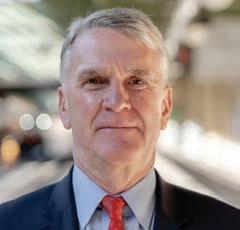


 Keynote Speaker Kevin S. Corbett President & CEO NJ Transit
Anna Hooven, P.E. Program Mgr. –Bridges & Buildings SEPTA
Je rey A. Warsh Partner & VP MBI Former Exec. Dir., NJ Transit
Joe Costigan, Jr. Rapid Transit Program Sponsor (Dir.) Metrolinx
Giuseppe Mattoscio, P.E. Chief Safety Engineer Houston METRO
Fred Mills, P.E. Chief Signal Engineer Houston METRO
Rachel J. Burckardt, P.E. VP / Sr. Project Manager WSP USA Inc.
Ken Luebeck, P.E. Public Project Mgr. Benesch
John Mardente Civil Engineer – Passenger Rail Div. FRA
Keynote Speaker Kevin S. Corbett President & CEO NJ Transit
Anna Hooven, P.E. Program Mgr. –Bridges & Buildings SEPTA
Je rey A. Warsh Partner & VP MBI Former Exec. Dir., NJ Transit
Joe Costigan, Jr. Rapid Transit Program Sponsor (Dir.) Metrolinx
Giuseppe Mattoscio, P.E. Chief Safety Engineer Houston METRO
Fred Mills, P.E. Chief Signal Engineer Houston METRO
Rachel J. Burckardt, P.E. VP / Sr. Project Manager WSP USA Inc.
Ken Luebeck, P.E. Public Project Mgr. Benesch
John Mardente Civil Engineer – Passenger Rail Div. FRA

Change is not for the faint of heart. A new book, Change Questions, tells us how to implement it, and how to make it stick.
BY SONIA BOT, CONTRIBUTING EDITOR, WITH D. LYNN KELLEY
“Every methodology I have seen has a step-by-step process. However, no two changes are the same; every change is different.”
– D. Lynn Kelley
The pace of organizational change has been increasing. Unfortunately, most change activities fail to deliver anticipated results. ose that do o en fail to sustain such change. e recently released change management book, Change Questions, A Playbook for E ective and Lasting Organizational Change, by D. Lynn Kelley with John Shook, addresses these critical issues by providing a proven process with a strong record of sustainment that can be used by anyone responsible for implementing organizational change. e book includes a case study with examples and stories of transformation at Union Paci c when Kelly was Senior Vice President of Supply Chain and Continuous Improvement. e initiative resulted in a dramatic increase in operational performance and a 96% sustainment rate over hundreds of change initiatives.
Retired from UP, Kelley is working for Brown Brothers Harriman’s private equity group, advising on railroad investments and manufacturing. With a Ph.D in evaluation and research, she has guided large companies such as Textron and UP through change management. She has held leadership roles in supply chain manufacturing, engineering and continuous improvement across diverse industries at a global scale.
SONIA BOT: What do you see as the unique value that your book and change questions methodology o er?
LYNN KELLEY: Every methodology I have seen has a step-by-step process. However, no two changes are the same; every change is di erent. erefore, the methodology should be able to ebb and ow and adjust to your own speci c needs. e questions approach lets everyone review these questions and decide what’s appropriate for them and their change. ey end up with a customized approach.
SB: Railroads are an entrenched industry and there’s some beauty to the entrenchment, but they need to keep moving forward.
ere are new entrant competitors coming, but there’s also extensive union involvement and there’s a skill and an art in terms of how to deal e ectively with all di erent parts of a
railroad or that type of environment. You can also say the same about complexity when you factor into your change initiative any external parties or other legal entities that come into your change initiative such as, for example, external business partners, suppliers, regulators and customers. Too o en, 60% to 70% of change e orts fail, but it doesn’t have to be that way. You’ve also experienced sustainable change.
LK: So o en we implement change as if failure is not an option, or if we mention failure, it will jinx it, rather than proactively recognizing that there is a high probability that it will fail unless we systematically approach the change. When I le Textron, we were at a 90% sustainment rate for our changes across all industries—35,000 employees, 32 countries and hundreds of di erent initiatives a year. It proved to me that just taking time before we implement a major change really pays the dividends. We measured it the same way at UP When I le there, we had a 96% sustainment rate, where much of the work included union employees in the eld, and what they were doing to increase productivity and network velocity.
SB: Many organizations and change practitioners tend to get stuck in a method and apply it generically as a checklist while missing key things, or they take shortcuts and cut out important steps, or they simply tinker, ying by the seat of their pants. How do Change Questions help reduce this risk?
LK: When I developed Change Questions, I kept pulling in anything that was relevant. I wound up with 11 questions. It’s bigger than your normal model, but unless you have a super complex change, you probably won’t address every question. e result is that you don’t overproduce too complex of an implementation plan, or underproduce one that’s not complex enough. You end up with a plan that’s “just right.” at was my goal with Change Questions.
SB: You provide many vivid case studies of your experience at UP, where your mandate was based on Lean being the underlying methodology. Lean is a way of thinking about creating needed value with fewer resources
and less waste, a practice consisting of continuous experimentation. We need to recognize that Lean thinking and Lean practice occur together. ere are 11 Change Questions. Let’s spotlight two. First Change Question: What is your value driven purpose for the change?
LK: is is a powerful question on many fronts. It includes two elements: value and purpose. “Flavor of the month” can occur when many big organizational changes get rolled out, and we don’t o en de ne the value we expect to get from the change. With Change Questions, we do it as the rst question. Later on, we’ll be trying to measure the change to see if we really are getting the value we expect. A value-driven purpose statement starts to give us alignment and set us on a direction. For example, railroads live and die by velocity. ey want to keep things moving. Union Paci c, like most railroads, has two main groups that work on velocity: dispatchers, and the transportation folks in the eld. ere are pairs of dispatching and transportation managers who own the corridors. We found at UP that, though you may think they’re aligned on purpose because they both had velocity as a goal, sometimes transportation would suboptimize dispatch velocity by making their own velocity better, and vice versa. We started pairing them up on that shared goal with a shared purpose. Velocity immediately started to go up. We found that people in the eld felt sometimes the speed limits were too low. And over the course of 150 years, maybe a curve had been straightened or a bridge had been added, but nobody went back to dispatch in every single circumstance and changed the speed limit. An astute pair got out, looked at everything, and found that they could go through their corridor and increase speed dramatically. Everybody else did it, and velocity improved. It was fantastic because we were aligned on purpose.
SB: Second Change Question: How will you establish a supportive management system with the appropriate leadership behaviors?
LK: One of the top reasons that change initiatives fail is lack of top leadership support. ink of a management system as the infrastructure that might be working against your change, things like how we’re measured.
ink of the example I just gave you. Each of those folks on velocity were being measured through their own department, which was working against the overall goal. It could be how you’re measured, how you’re promoted, the organization chart, etc. We need to see if there’s anything that’s con icting with the change we want to initiate.
At UP, we found we needed to teach proactive problem solving, addressing problems before they become a crisis. A railroad experiences a crisis daily, and we love and reward the re ghters, the people who can get us out of emergencies. We don’t say very much about the people that avoid the res. We needed to nd a way to reward not only the re ghters, but the people who proactively eliminate those res from happening in the rst place.
The second part of that Change Question involves leadership behaviors. The research doesn’t just say that it fails if leadership doesn’t support it. It mostly refers to visible leadership behaviors where employees get more than lip service. Employees can see that leaders are supportive of change. At UP, we did something called catchball . We went to leaders and said, “This is the change we’re going to implement. How can you show your people you support this? What could you visibly do?” But it’s something we have to do delicately so that mentally and psychologically, leadership is engaged in visualizing themselves,
supporting the change. That’s a big step in terms of change behavior and internal buy-in.
SB: One of the techniques you describe is the “20-60-20 rule.” It’s very e ective.
LK: No matter what change it is, 20% of people will be open. ey’re the change agents, the early adopters. en, 60% will be neutral. ey’re just going to wait around, not take a strong stance. e remaining 20% will resist. And if you just roll something out without any preparation, the negative people will have a loud voice in trying to dissuade people from making the change.
Yet, I also found you could use that curve to your advantage. ose who resist change are going to pull neutrals over it in the wrong direction. You have to drive momentum in the positive direction. At Union Paci c, in almost every situation, we tried some type of a pilot, an experiment, a simulation. If you get a spark of success, you immediately glom onto it and have the CEO talk about it. Everybody is listening, and the neutrals are saying, “We want that.” I strongly recommend that for anybody implementing widescale organizational change.
I want to brie y describe a panel survey we did at Union Paci c. We had a lot of quick and easy ways to check if we were succeeding, but we thought we’d adopt an idea from the medical eld, which does longitudinal studies. We randomly selected 400 people for a strati ed sampled, which meant that the sample was representative of the demographic proportions of the population. We reached out and said, “We’re doing this new initiative over the next four years. Will you sign up so we can send you a survey every six months that takes 10 to 15 minutes? Your results will always be anonymous, and you can mail them in, go on a website—however you want to complete your survey.”
If we had done the whole population, we would’ve gotten maybe a 10% to 12% response rate. You can’t make inferences with that. We got an 85% response rate over four years, and we could see where the change was working, where it wasn’t working, where leaders supported it and where they didn’t. By year three, we were able to correlate that with our top-level key performance indicators (KPIs). We saw that the top service units who bought into our program were the top ve in terms
of operating results and KPIs. Statistically, all their metrics were better than the other ones. We did a spot check. One service unit that was always at the bottom saw this and asked us to help. Within six months they went to the top of the KPI list. So in terms of operating results, it worked. e Change Questions helped sustain and course-correct. It was really rewarding to see that.
SB: at’s a great testament. I nd that, depending on the starting capability of the organization, sustained improvement ranges can be between 20% to 80%. If the approach is done properly, especially for the more complex changes, it requires having some experienced leaders and practitioners on the team, whether they’re outsourced or in-sourced, with both having academic theory and deep practical experience, with a proven track record as well.
Change Questions is available in print, on Kindle and on audiobook at amazon.com.
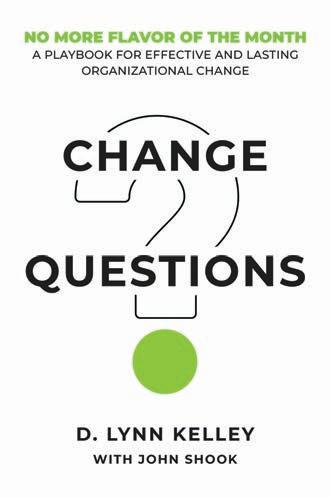
Sonia Bot, chief executive of e BOT Consulting Group Inc., has played key roles in the inception and delivery of several strategic businesses and transformations worldwide. She’s navigated through downsizing, rightsizing, de-regulations, SEC investigations, and economic downturns/scale-ups, let alone working through one of the most highpro le global corporate bankruptcies in the world. As a veteran innovator, change agent, high tech executive, and advisor she’s enabled organizations to deliver breakthrough results along with providing them a foundation to continue to excel. Her solid approaches to the evolution of companies and industries are game-changers that drive innovation and competitive advantage. Her experience ranges from Fortune 500 corporations to medium-sized ones, and start-ups. Sonia’s contributions to the rail industry are as a leader and a visionary who is passionate about taking railroading into the next generation. Sonia can be reached at info.botgroupinc@gmail.com or Sonia Bot | LinkedIn.


TrinityRail ® is North America’s leading railcar equipment and services provider. With a comprehensive platform of leasing, manufacturing, maintenance and professional services, you can rely on TrinityRail to fully deliver trusted expertise, innovative solutions and supply chain optimization. Learn more at TrinityRail.com.



During the late 1960s, famed folksinger Oscar Brand (who hosted a program for New York’s WNYC for more than 70 years) was hired to perform a number of advertising jingles for the Long Island Rail Road (LIRR) in radio commercials. He sang of “boxy trains for boxes” and of “shoppers’ trains for ladies, commuter trains for dads” and lots of other varieties of trains on the railroad, including “party trains for teens.” Prior to this, the LIRR in the 1950s created a nickname that stuck: “ e Route of the Dashing Commuter,” with its mascots, “Dashing Dan” and “Dashing Dottie.”
Times had changed greatly from the time the railroad began until Brand (who lived


 By David Peter Alan, Contributing Editor
By David Peter Alan, Contributing Editor
along the LIRR’s line to Port Washington) sang the railroad’s praises. ey have also changed greatly since then for the oldest railroad in the U.S. still operating under its original name and charter.
e Long Island Rail-Road Company began operations in 1834. Nobody thought about “commuting” that far back; the word had not yet been coined. Instead, the railroad’s purpose was to help provide a one-day trip between New York and Boston. Its main line had reached Greenport by 1844, which established the Boston route. Passengers would take a ferry from Manhattan to the LIRR dock at Williamsburgh, Brooklyn (which soon dropped the “h” from its
name), ride to Greenport, take another ferry to Stonington, Conn. (east of New London), and another train to Boston. e trip took about 11 hours. Today, it’s possible to make a similar trip, which takes about 8 to 9½ hours, depending on the day of the week, several hours more than a direct ride on Amtrak’s Northeast Corridor.
To provide as fast a trip as possible, the LIRR was built through the middle of Long Island and not through populated areas. Its business dropped o signi cantly when the Shore Line in Connecticut on the New York, New Haven & Hartford Railroad (predecessor of the NEC) opened in 1848, providing an all-rail route to New York. e LIRR faced nancial di culties at that time but kept going by concentrating on serving Long
In its 190th year, the Long Island Rail Road settles into new routines—and so do its riders.
Island itself. During the rest of the 19th century, it added several other lines, including the one to Montauk, and was able to buy other railroad companies on Long Island, including the New York & Flushing Railroad and the Central Railroad of Long Island.
e LIRR held a local railroad monopoly when the Pennsylvania Railroad (PRR) acquired it in 1900. e PRR began to electrify some LIRR trackage in 1905, and the 1910 completion of Pennsylvania Station in New York City eliminated the need to take a ferry across the East River. is allowed the railroad to develop its commuter services to places on the island, the mainstay of its operations ever since.
During the PRR period, the LIRR not only expanded its commuter network, but also ran trains to resort areas at the east end of the island: trains like the Cannonball (still running today as a seasonal weekend train) and the Sunrise Special to Montauk, and the Fisherman’s Special running an overnight schedule similar to one that still runs today, only without the name.
ere was also the Shelter Island Express to Greenport on the North Fork. e railroad still serves those routes, with an emphasis on summer service to the Hamptons and Montauk, but no longer with the parlor cars that ran back then.
By 1946, the PRR faced its own nancial di culties, and the State of New York began to subsidize the LIRR in the 1950s. at led to the State’s purchase of the railroad in
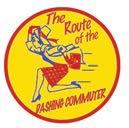

1965 and its transfer to the Metropolitan Commuter Transportation Authority, which became the MTA that we know today in 1968. Since that time, the MTA expanded electri cation, converted the entire railroad to high-level platforms, and modernized equipment, starting with the M-1 cars in 1970 and continuing through today’s M-9 models, as well as dual-mode locomotives and bi-level cars on its four non-electri ed lines.

e LIRR today consists of four lines within New York City converging at Jamaica, and nine branches east of there. e two major Manhattan terminals are Penn Station and the new deep-cavern Grand Central Madison (GCM), originally called East Side Access. e original tracks from Penn Station and the newly-constructed ones from GCM join just a er reaching ground level in Queens, and head to Jamaica. So does the Atlantic Branch from Atlantic Terminal in Brooklyn, which contains the rst tracks built by the LIRR in the 1830s. A few trains run to or from Hunterspoint Avenue in Queens during peak commuting hours. e line between Penn Station and Port Washington branches o at Woodside, Queens, west of Jamaica.
Headed east, the LIRR’s northern portion starts with the Main Line to Ronkonkoma and Greenport, also known as the Ronkonkoma Branch. It is only electri ed as far as Hicksville. Branching o from it are the
Port Je erson Branch (electri ed as far as Huntington), the Oyster Bay Branch (not electri ed), and the Hempstead Branch (electri ed, branching o in Queens). e spine on the south side of the island goes to Montauk, near the end of the island’s south fork. e electri cation and most of the trains only run as far as Babylon. ree electri ed branches split o from it at or near Valley Stream in western Nassau County, to Long Beach, Far Rockaway and West Hempstead. ere is also the Central Branch, which runs between Bethpage on the Main Line and Babylon. Only a few trains heading east of Babylon use it, and it has no station stops, but there are plans to electrify it.
Another major project that is part of the MTA’s 2020-24 capital plan is the LIRR Main Line Expansion, which completed a third track on ten miles of the Main Line, from Floral Park in eastern Queens to Hicksville on Oct. 3, 2022. e MTA says that line is used by 40% of LIRR customers.
For the rst time since Penn Station opened in 1910, there is now a new LIRR terminal in Manhattan. It is Grand Central Madison, the culmination of the multi-year, multi-billiondollar East Side Access project. GCM is located deep under Madison Avenue, slightly west of historic Grand Central Terminal, built in 1913 by the New York Central. (GCT hosts Metro-North, the MTA’s other commuter railroad.) Construction started in

2008, and the new terminal opened for business on Jan. 25, 2023 with limited service.
e rst month of service included only shuttle trains between the new station and Jamaica. Full service began on Feb. 27.
GCM has eight tracks on two levels, with two island platforms on each level. Tracks are numbered 201-204 and 301-304, as a continuation of the two-digit numbers for tracks on the main concourse at GCT and the 100-series numbers of the lower-level tracks at that station. Only single-level electric multiple-unit trains use the new terminal because the tunnel from there to Queens does not have enough clearance for bi-levels.
GCM’s concourse runs in a cavern under Madison Avenue, 140 feet below street level.
e platforms are located further down.
According to the MTA, from the GCM concourse to the mezzanine level between the 200 and 300 platform levels is 91 feet down. From those platforms, it took me eight minutes to walk to the historic headhouse at GCT, and ten minutes to get to 42nd Street. Riders going to buildings along Madison Avenue within a few blocks north of GCT can get to their destinations faster.
To some extent, it is obvious that the new terminal has added a degree of exibility for Manhattan commuters and other riders. In the most basic terms, the LIRR now serves both the East and West sides of Manhattan, where it previously served only the West Side. at observation begs the question of how much convenience the new terminal has added, and for how many riders. e time required to get from a platform to street level (and vice-versa) reduces the advantage for some riders, compared to continuing to use Penn Station.
It could be questioned to what extent the LIRR has established schedules that allow riders to go to or from the two Manhattan terminals more o en than was the case in the past, even though there are more trains today. Service patterns from either Manhattan station seem similar to the ones in e ect before GCM opened, so the additional trains might not translate to that much additional access.
e Babylon Branch, one of the busiest lines, features service to and from both Manhattan terminals, but there is hourly service to and from GCM, and separately
to and from Penn Station, with a few more trains to Penn. Most trains on the Far Rockaway, Long Beach and Hempstead Branches serve GCM, while only a few serve Penn Station, similar to the former pattern when most ran to or from Brooklyn. e nonelectri ed or partially electri ed lines carry times for both Penn Station and GCM with Note J, which means “Transfer at Jamaica,” similar to pre-GCM schedules that carried comparable information for Penn Station and Brooklyn.
On the Port Washington Branch, there is service about every 30 minutes at Woodside and points east, alternating between Penn Station and GCM. e Ronkonkoma Branch schedule has the same arrangement, but it does not indicate that a rider can “Transfer at Jamaica” for a train that came from the “other” point of origin. e limited Greenport service uses shuttle trains to and from Ronkonkoma.
ere are also four schedules for the “City Terminal Zone”: for Penn Station, GCM, Atlantic Terminal in Brooklyn, and Forest Hills and Kew Gardens, intermediate stops between Penn Station and Jamaica. While it might be feasible to check those schedules to determine whether a train from Penn Station can connect at Jamaica with a train from Grand Central Madison to a desired destination or vice versa, that maneuver is not easy or convenient, and is de nitely not suitable for the “uninitiated” occasional rider. Despite some objections to the new changes, there are now 115 morning-peak inbound trains through Jamaica between 5:38 and 9:29 AM and another 113 outbound trains between 4:29 and 8:16 PM. Nearly all of them originate or terminate at either Penn Station or GCM.
Atlantic Terminal in Brooklyn seems to have almost disappeared from the timetables on the LIRR section of the MTA website. e only line that features the Atlantic Terminal is West Hempstead, where weekend and opeak weekday service originates and terminates. On other lines, eight weekday through trains are scheduled to arrive in Brooklyn in the morning, and ve are scheduled to leave in the late a ernoon and early evening. e rest of the service consists of shuttle trains to and from Jamaica that use a new platform, separate from the platforms where trains
used to line up for transfers. ey are scheduled about every 12 minutes during commuting periods, every 20 minutes on weekends, and roughly every 30 minutes at other times on weekdays, although a few gaps are longer.
MTA spokesperson Dave Steckel said that less that 7% of LIRR riders go to Atlantic Terminal and praised the frequency of the current shuttle service, adding that the railroad will continue to monitor ridership and make changes. Since GCM opened for full service, a few trains have been added to the Brooklyn schedule, and some others have been shi ed from GCM to Penn Station.
Before GCM opened, trains had timed meets at Jamaica. e very phrase “Change at Jamaica” became a local expression among New Yorkers. e premise was that a train from Penn Station and a train from Brooklyn would meet at Jamaica for a crossplatform transfer. A er exchanging passengers, the trains would go their separate ways. ere were also three-way meets, where a train that originated at Hunterspoint Avenue or at Jamaica would be stationed on another nearby track, and the three trains would exchange passengers for all ultimate destinations. Former LIRR planner Joe Cli recalled, “Amazing to me was that you could transfer between two trains through a ‘bridge train’ in the middle.”
Steckel told Railway Age that the LIRR could not continue the traditional practice of timed transfers at Jamaica because there are now so many trains running that it is not feasible to hold trains for timed connections under current schedules. He suggested that customers use the TrainTime app to plan their trips. He also expressed concern that, if it became necessary for trains to wait at Jamaica for a late connection, it could cause cascading delays and possibly lead to service reductions in the future.
At the present time, the LIRR—the nation’s busiest commuter operation—touts major service improvements. Steckel said that there is 41% more service now than before GCM opened, and there are now improved “reverse commute” opportunities. ose certainly help, but time will tell just how much those changes improve mobility to, from, and on Long Island. It will also tell whether GCM was worth the cost in the long run.
With nearly half a billion riders annually on Siemens Mobility rolling stock and more than 100,000 data points remotely monitored on our rail infrastructure, we connect people and goods coast-to-coast with an interwoven network across America. As the largest passenger rail manufacturer in North America, our 4,000 team members and 2,000 suppliers in the U.S. create seamless transportation solutions that strengthen our nation. When we transform American rail, we transform the everyday. usa.siemens.com/mobility





Network and collaborate with a diverse group of women and allies who are making a difference in the rail industry. Learn how railroaders can maintain the momentum of inclusion, build strong support networks, and take advantage of ever-broadening career opportunities.
•Discover career advancement and development opportunities










• Learn about the career paths of women leaders and how today’s railways are supporting them

•Explore DEI (Diversity, Equity and Inclusion) initiatives



















• Learn about mentorship best practices—from finding a mentor, to serving as one
•Discover how ERGs (Employee Resource Groups) are established for community building and support
•Connect with your peers—both upcoming talents and accomplished women in rail






























































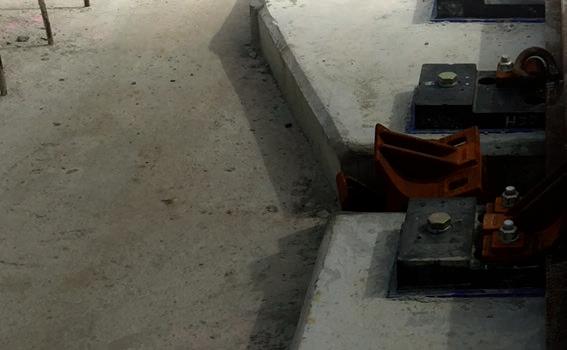

 BY CAROLINA WORRELL, SENIOR EDITOR
BY CAROLINA WORRELL, SENIOR EDITOR
Gauge-holding capability, resiliency, noise reduction, ease of installation and maintenance, low life-cycle cost, safety: Railroads rely on fasteners with these qualities from such companies as Progress Rail, Kawasaki Track Technologies, MxV Rail, L.B. Foster, Howmet, Lewis Bolt & Nut Company, Pandrol, J. Lanfranco and Vossloh North America to perform reliably and safely under tra c ranging from heavyhaul freight to high-speed passenger rail to transit. To meet these requirements, suppliers continue to make incremental updates to their system technologies. Railway Age contacted fastening system suppliers to nd out about their latest technologies. Following is a roundup of o erings from those which responded to our inquiries.

“Technology that improves safety and eciency continue to have a strong interest in the marketplace,” says Kawasaki Track Technologies. “We continue to utilize the latest machine vision and machine learning technologies to inventory fasteners and detect potentially defective fasteners.” Following a successful 2022 test in Japan, the company in February 2023 began testing a track fastener monitoring technology in North America. While installed on a locomotive, it will “capture high-resolution pictures and provide the necessary data for Kawasaki to utilize machine learning algorithms to identify potential track fasteners that need to be inspected and repaired.” Kawasaki employs cameras and global positioning sensors to identify potential defects. When the system
is complete, it will provide near real-time exceptions to its customers. Kawasaki plans to o er production systems for locomotives installations in early 2024. is technology, the company notes, will “continue to expand Kawasaki’s autonomous track inspection technology to enhance railroad safety and operating e ciencies.”
Progress Rail, a Caterpillar company, supplies a full line of fastening systems for heavy-haul and transit railways with options such as the e-Style Clip, the resilient Loadmaster DF (direct xation) for timber ties and the ADFF55 high attenuation direct xation fastener. For example, according to General Manager of Fastener Solutions Hakan Eksi, the DF Block System “dramatically improves the quality of direct xation fastener installations for standard and high attenuation units” and “eliminates the risk of irregular support surface conditions such as concrete honeycombs and improper elevation setting of a concrete embedded insert.”
On the Los Angeles Metro Westside Purple Line Section 1, the DF Block system “has reduced installation time with less material handling and fewer personnel required for the same work,” Eksi notes. It improves life expectancy of DF units, reduces maintenance and provides a signi cant initial installation savings as compared to the 30-plus-year-old
top-down construction technique.
MXV RAIL
e fastener test zones at MxV Rail’s new Facility for Accelerated Service Testing (FAST) include various designs and con gurations of tie plates, fasteners, spikes, and anchors, according to Principal Investigator Yin Gao. To evaluate performance in a challenging environment, Gao says the fastener test zones have been installed on a sixdegree curve with a ve-inch superelevation and experience tonnage accumulation from a train of loaded 315,000-pound GRL cars operating at 40 mph.
e primary fastener test zones at FAST are listed in the gure (above). Elastic fasteners are o en used on track located on
grades with a high degree of curvature since they provide greater resistance to rail rollover and gauge widening, Gao says. Curve blocks also provide rail rollover resistance while allowing rail more freedom to expand and contract longitudinally.


According to Gao, newly designed anchors and screw spikes are being tested to evaluate their service life and performance in comparison to traditional components. “ e railroad industry will bene t from improved understanding of the longevity and potential failure modes of these fasteners,” Gao adds.
VOSSLOH
Vossloh’s new M-generation clamp is born from targeted research and development
around vehicle-track interaction, resulting in signi cantly higher natural frequency, the company tells Railway Age. e M-generation tension clamps have many other design bene ts.

Compact in design, the outwardly curved spring arms “are the most striking feature of the new tension clamps.” eir geometry, which resembles a cursive “M,” “provides both a larger contact area to the rail base (reduced contact stress) and increased three-dimensional fatigue strengths.” e wide-spread spring arms also increase fastening torsional resistance, “improving lateral track stability and buckling resistance without disturbing the ties and ballast or requiring speed restrictions.”
“A hot topic for railroads today is track buckling; torsional resistance by using the M-generation can be more than 100% higher than traditional fastening systems,” according to Vossloh. A new micro-steel alloy, low stress bending and an enhanced hardening process contribute to improved performance and decreased CO2 emissions. is, Vossloh says, “lowers life cycle costs on a comparative basis and allows the use of more elastic rail fastening systems to further increase robustness and safety.”
Vossloh says the M-generation is “100% compatible with existing rail fastening systems and combines properties of several previous clamp designs, reducing complexity in track and spare parts stock.” e M9 is made for U.S. rail infrastructure. Appropriate for almost all North American applications, Vossloh says it has been installed in “multiple demanding Class I revenue service locations over the past two years to con rm
its operational capability and will continue to roll out more widely to commuter lines.”
Lewis Bolt & Nut Company’s most recent product launch is the Viper-1® drive-on anchor, says Senior Assistant Vice President of Sales George Apostolou, who adds that the Viper-1® “exceeds American Railway Engineering and Maintenance-of-Way Association (AREMA) Chapter 5, Section 7.1.4 requirements and has a minimum holding power of 9,000 pounds vs. 6,000 pounds (AREMA 7.1.4, Part B).”
In addition, the Viper-1® “has a much higher re-application rate than any current anchors on the market,” Apostolou says. “ e anchor can be removed and reapplied multiple times because of improved sti ness in the design of the anchor jaw.” Another key bene t is “the larger bearing surface against the tie. e Viper-1® boasts 75% more bearing surface than standard drive-on anchors. is results in increased tie life preventing movement and damage to the tie surface. In addition, Viper-1® o ers an increased life cycle that is designed to last the life of the rail.”
“Market conditions have remained strong year-to-date in 2023, and with the adoption of the Viper into the market we expect that to continue into 2024,” notes Apostolou. When asked to comment on the company’s overall business outlook regarding grant money currently available, Apostolou said that although the company “does not see any grant money directly, our sales do benefit from this its availability. We just quoted a large project for Genesee & Wyoming’s Rapid City,

L.B. Foster Company has been supplying vulcanized rubber bonded DF fastening systems to transit agencies across the U.S. and Canada for more than 40 years. e company’s Transit Products Division “specializes in the design and development of noise and vibration mitigation and electrical isolation technologies.”
L.B. Foster o ers a line of more than 50 fastening systems, each “uniquely designed” to o er varying sti ness and resiliency, rail seat width and height accommodations, lateral adjustment, and anchoring locations in a “single, easy-to-install unit,” the company says. “Our engineering team partners with our customers to design new fastening applications to meet their specications and design requirements,” L.B. Foster tells Railway Age
Additionally, L.B. Foster’s research and development team is engaged in prototyping and testing alternative materials and manufacturing processes. “This ongoing effort aims to continually enhance the performance and lifespan of our fastening systems,” the company tells Railway Age . “Our teams are diligently researching adaptable methods to improve noise and vibration mitigation, aligning our solutions with the evolving needs of our customers and the changing landscape of the transit sector. Additionally, we are working on advanced aluminum contact rail designs that promise to deliver superior electrical performance for every pound of installed weight.”
Railroads & Economic Regulation traces the development, failures and successes of railroad economic regulation by an insider who was a White House appointed chief of staff at the Surface Transportation Board and a senior officer at the Association of American Railroads.
“Frank Wilner has written an exhaustive history of our nation’s railroads and the complicated, intriguing and often confusing federal regulation and lawmaking.”
Nick Rahall Member of Congress (West Virginia, 1977-2015)“As a new member of the Surface Transportation Board, the book would have been indispensable to me. It places today’s regulatory issues into context based on their history and paints a picture of the characters who have made the railroad world what it is today.”
“This definitive work expertly explains how a century of overregulation nearly strangled railroads, and how partial deregulation in 1980 helped save them.”
Bill Stephens Trains Magazine columnist(An Insider’s Account)
BKRER — $69.00 plus S/H
Debra L. Miller Member, Surface Transportation Board,
2014-2018
“The quality and depth of Wilner’s research provides a needed road map through the labyrinth of railroad regulation. It is a valuable resource for future policy decision making.”
 Dr. Harvey A. Levine Retired, Vice President, Economics & Finance Association of American Railroads
Dr. Harvey A. Levine Retired, Vice President, Economics & Finance Association of American Railroads
“This is a book as enjoyable as it is essential. To understand America’s economy, one needs to understand railroads, and to understand railroads, one needs to understand the story of their economic regulation.”
Chuck Baker President American Short Line & Regional Railroad AssociationThe global rail industry’s single-most important communications and signaling event since 1995.
•Network with fellow signaling and train control professionals.
• Learn innovative approaches to implementing advanced technologies.
•Discover new methods for procurement and contracting.
•Become better-informed on current R&D initiatives.
• Acquire in-depth knowledge on planned and ongoing projects.


•Discover upcoming regulations and how they impact your business.
OCTOBER
26 & 27, 2023
The Bellevue Hotel
Philadelphia, PA
Sponsorships: Contact Jonathan Chalon to discover marketing opportunities, (212) 620-7224, jchalon@sbpub.com.
www.railwayage.com/nextgen











 MARIO PELOQUIN President & CEO VIA Rail Canada
CHRIS MATTHEWS AVP Network Control Systems BNSF
SOFIA GEORGIADIS VP Vital Systems, Signals & Train Control MTA C&D
BRAD MYERS EVP & COO Amsted Digital Solutions
YOUSEF KIMIAGAR VP Advanced Technologies, U.S. Rail Systems Lead Hatch
PHIL DUBERY Co-Owner & Dir. CPC Project Services LLP
ALAN RUMSEY, PH.D. Rumsey Transit Systems Consulting
GARY FRY, PH.D., P.E. VP Fry Technical Services
DAVID SHANNON General Manager RailPulse
MARIO PELOQUIN President & CEO VIA Rail Canada
CHRIS MATTHEWS AVP Network Control Systems BNSF
SOFIA GEORGIADIS VP Vital Systems, Signals & Train Control MTA C&D
BRAD MYERS EVP & COO Amsted Digital Solutions
YOUSEF KIMIAGAR VP Advanced Technologies, U.S. Rail Systems Lead Hatch
PHIL DUBERY Co-Owner & Dir. CPC Project Services LLP
ALAN RUMSEY, PH.D. Rumsey Transit Systems Consulting
GARY FRY, PH.D., P.E. VP Fry Technical Services
DAVID SHANNON General Manager RailPulse
Welcome to “Timeout for Tech with Gary T. Fry, Ph.D., P.E.”
Each month, we examine a technology topic about which professionals in the railway industry have asked to learn more. is month our subject is stress in engineering materials.
“What is stress?” is is unarguably the most common question that I have been asked over the years. And it’s a tough one!
Various concepts of stress in structural materials have been with us for more than ve centuries, beginning with Leonardo da Vinci in the 1490s. By the early 1820s, Augustin-Louis Cauchy had mathematically formalized a de nition of stress that we now take for granted. In the 300 years between da Vinci and Cauchy, many famous scholars worked on what today would be considered problems in stress analysis, including Galileo, Hooke, Newton, members of the Bernoulli family, Euler and many others.
Today it is Cauchy’s theory of stress that is most commonly implemented to perform a stress analysis of engineering materials under load, such as steel railway rails, wheels and bridges. is makes our modern understanding of stress in materials slightly more than 200 years old—roughly as old as the rst railways.
So, what is stress? Consider Figure 1 (above), which is a photograph of a stretched rubber band. Everyone understands that this system contains energy just waiting to be released at an opportune moment. In mechanics of materials, we call this energy strain energy, and stress is one of its two constituent factors—the other being strain.

Stress quanti es the intensity of internal forces that are distributed throughout a material when it is loaded. Stress is the component of strain energy that will cause the material to break, and that is why it is such an important concept. In fact, it was the desire to understand failures of structural components, such as beams, that originally
led da Vinci, Galileo and others to our earliest concepts of stress.
In Figure 1, stress is the force in the rubber band per unit of cross-sectional area of the band and has units of pressure, for example pounds per square inch (PSI). Stress is invisible, and though it is never directly measurable, it can be calculated using appropriate mathematical expressions. In Figure 1, strain is the stretch in the band per unit length of the band and is e ectively dimensionless with units of inches per inch (in./in.), for example. Strain is always manifest in the visible deformation of a material and can be measured.
Cauchy’s de nition of stress allows us to quantify the strength of a material by testing the material to failure and performing a stress analysis to determine the level of stress that caused the failure. Subsequently stress analysis allows us to ensure we are applying load to a material safely. We do this by limiting the maximum stresses in a material to levels reliably
Dr. Fry is Vice President of Fry Technical Services, Inc. (https:// www.frytechservices. com/). He has 30 years of experience in research and consulting on the fatigue and fracture behavior of structural metals and weldments. His research results have been incorporated into international codes of practice used in the design of structural components and systems, including structural welds, railway and highway bridges, and high-rise commercial buildings in seismic risk zones. He has extensive experience performing in-situ testing of railway bridges under live loading of trains, including high-speed passenger trains and heavy-axleload freight trains. His research, publication, and consulting have advanced the state of the art in structural health monitoring and structural impairment detection.
 BY
BY

below its strength. at is why experts sometimes remark that a failed component was “overstressed.”
In summary, stress is a mathematical concept that solves a set of partial di erential equations. Stress in materials is invisible and not directly measurable. Modern stress analysis techniques allow us to accurately estimate three-dimensional stresses in many types of components under many types of complex loadings. For example, Figure 2 shows a contour plot of stresses calculated from an analysis of wheel/rail contact. Figure 3 shows a contour plot of stresses calculated from an analysis of a steel railway bridge loaded by a train.
Five-hundred years ago, an idea was rst conceived that a loaded material was subjected to stress that might be quanti ed based on the geometry of the material and the nature of the loads applied to it. Now, stress analysis is a routine and critical part of ensuring the safety of the engineered systems we depend on every day.


What exactly is stress? It’s a tough—and often-asked— question.
GARY T. FRY, PH.D., P.E., VICE PRESIDENT, FRY TECHNICAL SERVICES, INC.Figure 2. Contour plot of stresses from an analysis of wheel/rail contact. Figure 3. Contour plot of stresses from an analysis of a railway bridge.
FRA News: There are no new proposals or final rules to report for this issue. Be sure to check back next month to see if there are any changes to FRA regulations.
49 Part 213, Subparts A-F. Classes of Track 1 through 5: Applies to track required to support passenger and freight equipment at lower speed ranges. Includes Defect Codes and Appendices A, B, and C to Part 213. Softcover. Spiral bound. 120 pages.
Updated 1-6-23
BKTSSAF Track Safety Standards, Subparts A-F $11.95





Order 50 or more and pay only $10.75 each
49 Part 213, Subparts G. Classes of Track 6 and higher. Softcover. Spiral bound. 88 pages.
BKTSSG Track Safety Standards, Subpart G $12.50 Order 50 or more and pay only $11.25 each
The FRA’s Railroad Workplace Safety standards address roadway workers and their work environments. Subparts A-General, B-Bridge Worker Safety Standards, C-Roadway Worker Protection, D-On-Track Roadway Maintenance, and Defect Codes for Part 214. Spiral bound. Updated 1-6-23
BKWRK Railroad Workplace Safety $11.50 Order 50 or more and pay only $10.35 each

FRA Part 237 establishes Federal safety requirements for railroad bridges. This rule requires track owners to implement bridge management programs, which include annual inspections of railroad bridges, and to audit the programs. Bridge Safety Standards Part 237 also requires track owners to know the safe load capacity of bridges and to conduct special inspections if the weather or other conditions warrant such inspections. Spiral bound. Updated 3-21-22
BKBRIDGE Bridge Safety Standards $8.95
Order 50 or more and pay only $8.00 each
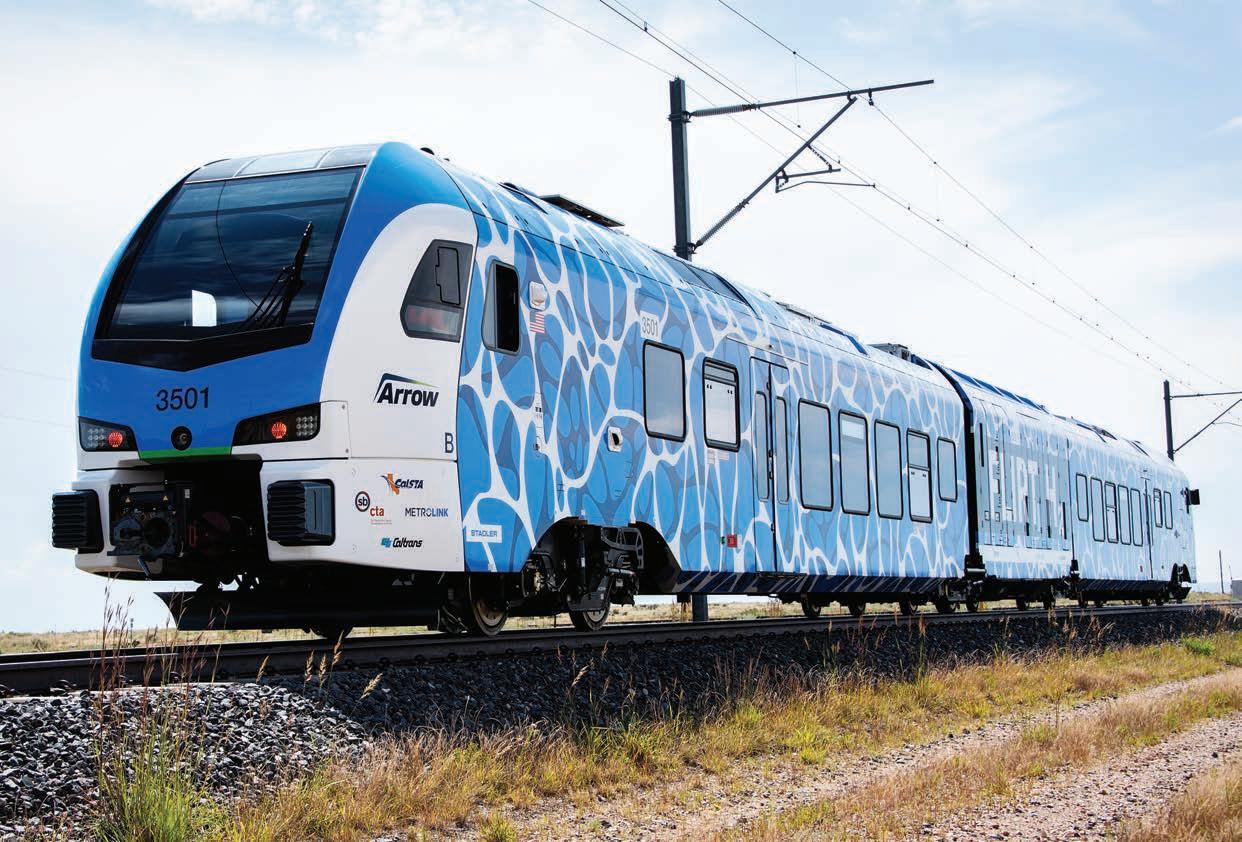 BY BORIS NEJIKOVSKY, SPECIAL ADVISOR, AND MATT DEGEORGE, SENIOR RAILWAY RESEARCH ENGINEER ENSCO, INC.; AND LUCY ANDRE, CHIEF OF STAFF, STADLER US INC.
BY BORIS NEJIKOVSKY, SPECIAL ADVISOR, AND MATT DEGEORGE, SENIOR RAILWAY RESEARCH ENGINEER ENSCO, INC.; AND LUCY ANDRE, CHIEF OF STAFF, STADLER US INC.
Decreasing greenhouse gas (GHG) emissions in transportation remains a topic of intense attention for the government, the industry and the public. According to the U.S. Environmental Protection Agency (EPA), the transportation sector is responsible for the largest share of greenhouse emissions in the country (28% in 2021). Other sectors (electrical power, industry, agriculture, commercial and residential buildings) each emit less. Although the transportation sector consumes less energy than the industrial sector, it generates more GHG emissions due to its near complete dependence on petroleum fuels.
The U.S. government set a goal to achieve a 50-52% reduction in U.S. GHG emissions by 2030, and a net-zero economy by 2050. To achieve this goal, the transportation sector’s dependence on petroleum fuel must be decreased. One promising approach for rail transportation is the use of hydrogen fuel. In January 2023, the Department of Energy (DOE), Department of Transportation (DOT), EPA and Department of Housing and Urban Development (HUD) jointly released the U.S. National Blueprint for Transportation Decarbonization, which identified the strategic role of clean hydrogen in decreasing emissions. According to this
blueprint, “Hydrogen offers a strong value proposition for applications requiring long driving ranges, fast fueling, and large or heavy payloads”—all typical characteristics of rail transportation.
Hydrogen is important for decreasing emissions because it is a very clean fuel. Hydrogen powered vehicles do not generate GHG emissions. If the hydrogen used is produced using renewable energy sources like solar and wind (so-called “green hydrogen”), GHG emissions are practically eliminated throughout the whole supply chain.
Hydrogen has other significant advantages as an energy carrier. It is very light and has the highest specific energy (energy content per unit of mass) of all
common fuels. This is one reason why hydrogen is used as a fuel for many modern rocket engines. According to a DOE fuel properties comparison, 1 pound of hydrogen contains the same energy as 0.4 gallons (approximately 2.8 pounds) of diesel fuel. In practical applications, hydrogen requires high pressure or cryogenic storage tanks that somewhat decrease its advantage for smaller vehicles. However, the requirement for specialized storage tanks is easier to fulfill in larger and heavier machinery, such as railway vehicles.
Hydrogen-powered trains have been in service in Germany since 2018 and have completed trials in several other European countries. In 2019, Stadler US Inc. (a U.S. subsidiary of Swiss train manufacturer Stadler Rail) was awarded a contract from San Bernardino County Transportation Authority (SBCTA) to deliver the rst-inthe-U.S. hydrogen-powered trainset with an option to order four more in the future.
e train is called the ZEMU, for “Zero Emission Multiple Unit.”
The ZEMU uses a combination of hydrogen fuel cells and batteries for propulsion. Electrical power is created by combining hydrogen with oxygen in on-board fuel cells. The reaction between hydrogen and oxygen produces purified water and heat. When the ZEMU operates, it emits only water vapor, meaning cleaner air and less global warming. When the hydrogen itself is produced by green methods, the total system can achieve zero carbon emissions.
The ZEMU consists of two cars with a power module in between that holds the hydrogen tanks and fuel cells that generate electricity for the traction motors. The trainset has seating space for 108 passengers in addition to generous standing room, and can transport passengers with a maximum speed of up to 79 mph. It is expected to start operation as part of the Arrow service between San Bernardino and Redlands, Calif. in 2024.
The first ZEMU train arrived in the U.S. in September and is being tested at the DOT Transportation Technology Center
(TTC) in Pueblo, Colo. ZEMU tests are conducted by Stadler’s test engineers supported by ENSCO TTC personnel. The testing program consists of two phases. The first phase, taking place now, includes static lean, wheel load equalization and battery charging capacity tests.
The second phase consists of dynamic on-track tests required for train acceptance, including acceleration and deceleration, maximum speed, brake performance, EMI radiation, PTC and train radio, ride quality and other tests. The second phase will also include a set of tests specific for hydrogen powered propulsion, including verification of vehicle range, fuel consumption, propulsion performance, refueling operations and zero emissions verification.
Dynamic on-track tests of ZEMU will be conducted at TTC’s Transit Test Track (TTT) and/or the Railroad Test Track (RTT). The TTT is a 9.1-mile loop designed to simulate urban rail settings, including tight-turn curves. The RTT is a 13.5-mile loop for testing trains in a broad range of speeds up to 165 mph. Both tracks provide great flexibility in terms of train movements and allow Stadler and ENSCO test engineers to evaluate various operational scenarios.
Both Stadler and ENSCO have paid particular attention to proper fueling operation and fuel storage at TTC. ENSCO has established a roadmap with support of our partners that includes a short-term solution and a longer-term plan to establish a permanent hydrogen fueling station and to conduct hydrogen transportation research and testing at TTC.

The North American railway industry needs alternative green energy sources, such as hydrogen trains to meet increasing sustainability requirements. The TTC is proud to support the first U.S. hydrogen passenger train testing and is ready to support all future research and testing needs to enable a safe and sustainable transportation future.
Industry professionals can get a first peek at the Stadler ZEMU at APTA EXPO in Orlando, Fla., where Stadler will be presenting the vehicle for the first time in the U.S. Further, the Stadler ZEMU is scheduled to return to TTC by Nov. 7.
Be sure to check out the TTC First Annual Conference & Tour Nov. 7-8 to learn more about the TTC’s role to support future transportation. More information can be found at https://ttcconference.com/.
HIGH PROFILE: CSX on Sept. 8 named veteran railroad operating executive Mike Cory as Executive Vice President and Chief Operating Ofcer. Cory replaces Jamie Boychuk, who departed CSX on Aug. 4.
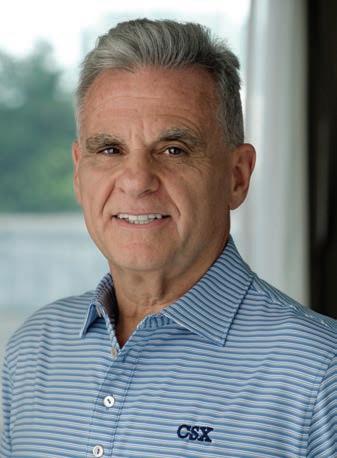
Cory, with more than 40 years of operations experience, retired from CN in 2019 as EVP and COO, and since then has provided transportation consulting services. Cory began his railroad career in 1981 as a laborer in the CN locomotive shops in Winnipeg, Canada. Over the years, he rose through the ranks as a superintendent, general superintendent, director of service design, network operations superintendent and general manager of operations for CN’s Michigan Sub-region. He also held customer service and marketing positions. In 2006, he assumed a series of senior leadership roles, including Vice President of Network Operations, Senior Vice President Eastern Region and Senior Vice President Western Region. He was named EVP and COO in 2016.
William E. (Bill) Greenwood, a former Burlington Northern executive most associated with the railroad industry leadership he provided for the intermodal business, died on Sept. 22, 2023. He was 85.
Aside from his faith and family, Greenwood’s greatest love was the railroad business. While a student earning a finance degree from Marquette University, he worked summers for the Chicago, Burlington & Quincy (CB&Q), starting in 1956 as a telegrapher and tower operator. After graduation, he worked for the First National Bank of Triumph, Ill., for two years so he could help care for his family after his father died. He then rejoined the CB&Q in 1963 and served in a variety of operating positions: demurrage supervisor, traveling car agent, assistant trainmaster, regional manager freight equipment, and trainmaster based in Chicago, Lincoln, Ill., and Omaha. Following the 1970 merger of the CB&Q into the Burlington Northern (BN), he progressed rapidly up the corporate ladder. He served as Assistant Superintendent of BN’s Chicago terminal, staff assistant to the Regional AVP Operations in Chicago,
Director of Corporate Planning in St. Paul with a prime responsibility for planning BN’s buildup of its Powder River Basin coal business, and Superintendent of the Minneapolis/ St. Paul terminal, including its new flagship Northtown Yard. He was then was promoted to Superintendent of the Alliance Division while BN was engaged in building its massive coal business infrastructure. With the advent of partial deregulation of the railroad industry in 1980 under the Staggers Rail Act, BN formed strategic business units to help it take advantage of capabilities to do business in new ways. Greenwood was recruited from Alliance back to St. Paul to lead the new Intermodal Business Unit as Senior AVP Intermodal, running what is historically known as BN’s “Piggyback” and automotive businesses. He was subsequently promoted to VP Intermodal, Senior VP Marketing and Sales in Fort Worth, Executive VP Marketing and Sales, and Chief Operating Officer. Greenwood was a pioneer in the adoption of participative management in what historically was a command-and-control-oriented railroad industry. He was a champion of exploiting innovation in a newly deregulated industry to
dramatically improve employee safety, customer service and financial performance. He is considered a “founding father” of the railroad industry’s intermodal business. Before and during Greenwood’s early direct involvement, intermodal was an industry afterthought and, in many cases, considered an illegitimate child that faced incredible resistance and obstruction. It has now become a vital pillar of the railroad business and the global supply chain and a key to the prosperity the railroad industry has experienced in the 2000s. His accomplishments as an intermodal pioneer were recognized in 1992 when he was awarded the Silver Kingpin Award by the Intermodal Association of North America. His innovative intermodal business accomplishments and management approach were documented in Chapter 2 of the book The Wisdom of Teams The cooperation we have in the trucker/railroad supply chain today is largely due to Greenwood’s influence. He led the charge to hire truckers to run BN’s Hub Centers, as well as the quest to improve rail intermodal service quality so that TL carriers, not just UPS and LTL carriers, would be compelled to use rail for substitute linehaul service. As I cite in my book, Against all Odds – The History of Burlington Northern Railroad’s Innovative Intermodal Business, Don Schneider told Greenwood in the 1980s that there would never be a day a Schneider National shipment went over rail. However, under Greenwood’s leadership, BN later strongly compelled J.B. Hunt into domestic containerization. Greenwood’s leadership also resulted in a renaissance for BN’s core grain business. Just as he pioneered the use of motor-carrier-experienced executives in intermodal, he pioneered the use of executives from the grain merchandising industry to lead BN’s grain business. This resulted in innovations like Certificates of Transportation Service (COTS) for which BN grain carrying capacity was offered to the market through open bidding instead of traditional tariffs and contracts. This, combined with innovations, such as dedicated unit grain train service for high-capacity, high-productivity elevators and use of the industry’s largest fleet of carrier-controlled, heavier-axle-loading cars, transformed the business from one that was marginally profitable and struggled to justify reinvestment to one that was among the most profitable in BN’s portfolio.
– Mark S. Kane







As this column is written, the federal government is either shut down or operating under a short-term Continuing Resolution. Whether shut down or just limping along, there appears to be little appetite for compromise between the warring factions in Congress. Be that as it may, the short line industry has much governmentrelated business to concern itself with in the coming months.
In a Sept. 7 Notice of Proposed Rulemaking (NPRM), the Surface Transportation Board (STB) closed Docket No. EP 711 Sub No. 1 and proposed a new set of regulations (Sub No. 2) that would provide for the prescription of reciprocal switching agreements to address inadequate rail service as determined by using objective standards. Comments are due Oct. 23. This proposal shifts the conversation about STB measures to a service-based standard in a way that makes sense to many short lines.
Throughout the comment period on EP 711, ASLRRA argued that short lines should be exempt from that proposed rule, and that appears to be the case under the new NPRM. But as the saying goes, the devil is in the details, and our Oct. 23 comments will address those details to ensure that short lines are not inadvertently subject to the proposed rule. Short line railroads generally only serve a limited number of predominantly small- and medium-size shippers and only survive by providing those shippers flexible and reliable first-mile/ last-mile service. It is critically important for both the short lines and shippers that this rail service is not jeopardized by a regulation not relevant to a typical short line operation.

The CRISI program has been an important source of infrastructure funding for short lines. It is the only federal program that short lines are directly eligible for, and the matching portion is typically affordable for small businesses. The recently announced FY22 awards were record-breaking for our industry. Short lines garnered 47 of
the 70 projects awarded for $720 million, about half of the $1.4 billion available. We applaud Congress for continually recognizing the value of short line railroads, and the FRA for carrying out Congressional intent when evaluating projects for this round of funding.
Short line projects selected include those that will address safety with grade crossing improvements, trespassing mitigation elements, upgrades to track to the 286,000-pound GRL standard, bridge repairs, and rail environmental impact improvments retrofitting or purchasing locomotives to achieve Tier 3, Tier 4 or zero emissions status, and more. Although $720 million puts a real dent in the short line state-of-goodrepair backlog, we are hardly done. We expect to see a combined FY23 and partial FY24 NOFO for CRISI as soon as December or January. We are working to ensure that the program is funded at the highest possible levels for FY24 and beyond and that short lines are in position to compete vigorously for those opportunities.
Short line CRISI awards are the best bang around for the public buck as short lines are expert in investing scarce resources wisely in projects that improve safety, add value to the shippers they serve, and enhance the interconnected freight rail industry.

Somewhat off our regular beaten path, ASLRRA is also supporting two new legislative initiatives this Congressional Session. The first is a short line disaster relief bill (H.R. 3782) introduced by Congressman Byron Donalds (R-Fla.). Short line railroads are generally not eligible for disaster relief from FEMA, and SBA loans are insufficient. U.S. DOT has emergency relief programs at the FTA and FHWA, but there is nothing at the FRA that can be deployed quickly to assist small railroads facing disaster damages. The program envisioned is designed to help when insurance and other resources are not available. This is a bi-partisan bill that currently has 20 co-sponsors.
Congress recognized the gap in the
federal disaster relief framework in 2008 with a $20 million one-time appropriation responding to a cluster of natural disasters that damaged 17 short lines in the Midwest. This program is modeled on that successful effort.
The current political deadlock in Congress highlights the need for a permanent program that is ready when needed. It is imperative to restore basic infrastructure promptly following a disaster to facilitate the broader response and recovery efforts. Short line rail service is a key piece of that recovery, shipping relief supplies and materials into, and damaged materials out of, the area. Quickly restoring service is equally important to shippers who absolutely depend on their short line to keep their small businesses up and running. The need for immediate relief should not be dependent on Congress’s ability to act quickly.
The second legislative initiative is a proposed new program that would help short line agriculture shippers fund infrastructure projects to improve loading facilities, increase storage capacity, improve access between shipper and short line infrastructure and acquire additional railcars. The program would be included in the new five-year Farm Bill, which must be reauthorized in this Session of Congress, and we are currently working with a large group of individual shippers to develop appropriate legislative language and secure a bi-partisan group of House and Senate sponsors.
The short line industry has a lot of business to conduct with the Congress in the coming months, and it is our hope that this column finds the government open for business.























Renting

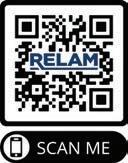












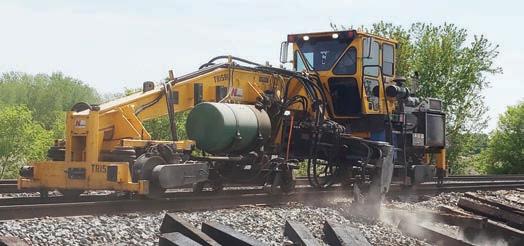


 Harsco Mark IV Production Tamper
Harsco Mark IV Production Tamper